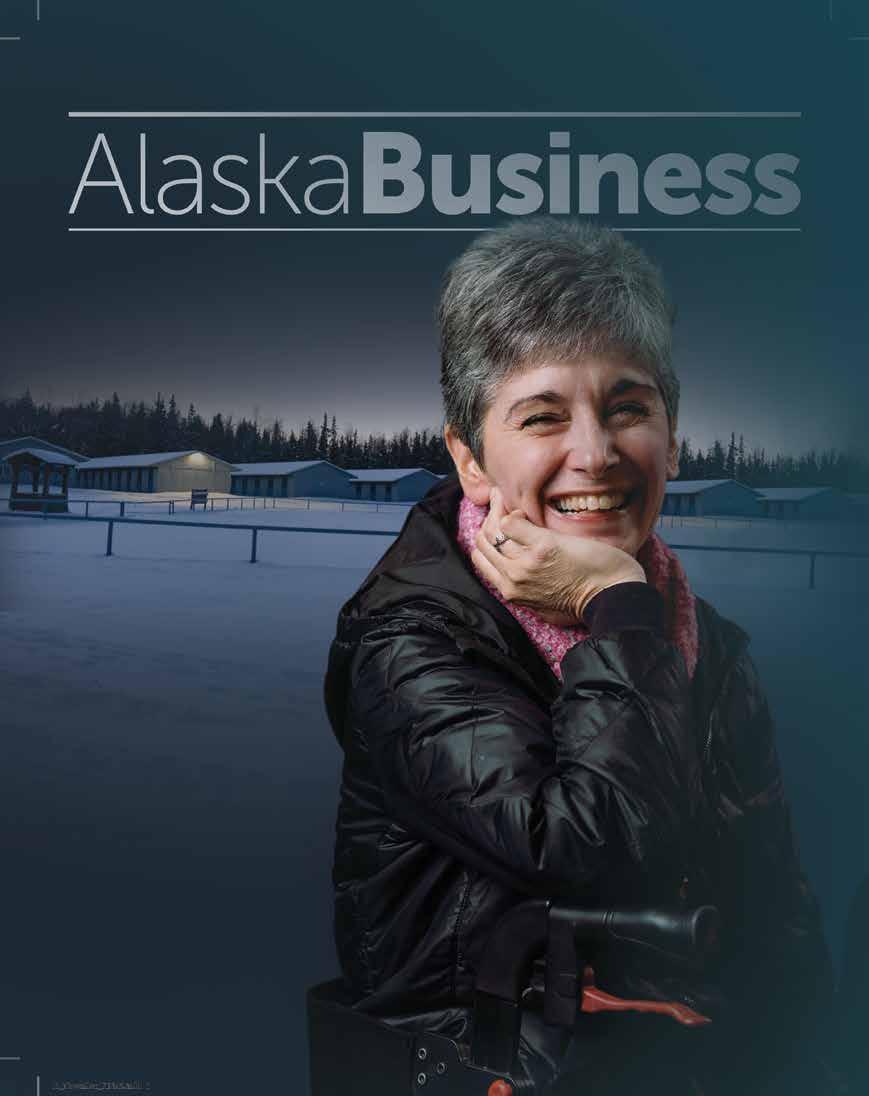 Christy Constantini Executive Director
Christy Constantini Executive Director
DECEMBER 2022 HEALTHCARE | ALASKAN-MADE PACBAK | ALYESKA’S NORDIC SPA
Equine Assisted Therapy Alaska
Seward Highway, AK
A thousand factors impact your bottom line every day. Some in your control, some well beyond it. One thing you have the power to choose is who you work with.


Our job is to keep you moving forward. Our machines are engineered with a “get it done” mentality and our After Sales Solutions are designed to keep you up and running.

The tougher your job gets, the easier it is to see we’re here when Hitachi
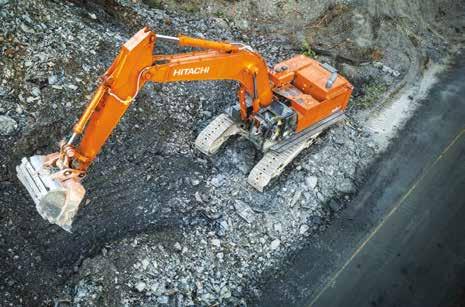
hitachicm.us
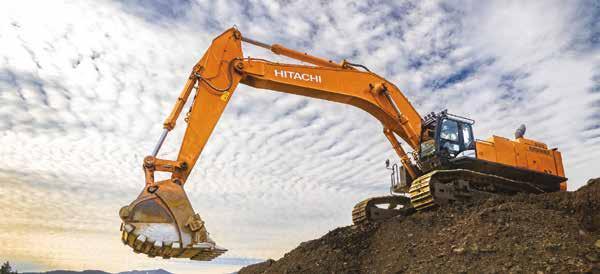
PROTECTING YOUR REPUTATION AND YOUR BOTTOM LINE.
Construction Machinery Americas Inc.
Anchorage, Alaska (907) 563-3822 Toll Free (800) 478-3822 Juneau, Alaska (907) 780-4030 Toll Free (888) 399-4030
Fairbanks, Alaska (907) 931-8808 Ketchikan, Alaska (907) 247-2228 IN THE WORLD Hitachi, the best in construction equipment technology IN ALASKA CMI, the best sales and product support lineup IN YOUR CORNER The Winning Team www.cmiak.com
Alvin Ott Fairbanks Branch Mining Sales
Jay Ahrenholz Anchorage Branch Sales Rep.
Seward Highway, AK























©2022 Alaska Communications. All rights reserved. Terms and conditions apply. Service not available in all areas. TWO SATELLITE NETWORKS. ONE TRUSTED CONNECTION. Alaska Communications is designing solutions to fully meet the future demands of increased traffic and secure data needs in Alaska. By combining the strengths of Low Earth Orbit (LEO) and Geostationary Equatorial Orbit (GEO) satellite networks, you'll experience faster speeds for data transmission, and time-sensitive applications prioritized over the low-latency path. With LEO-GEO integration, we are delivering a multi-path satellite solution with a landing station in Alaska, for a best-of-class experience with the flexibility to meet your growing healthcare operation needs. Contact Alaska Communications to learn more at tellmemore@acsalaska.com
By Dan Kreilkamp
 By Tracy Barbour
By Tara O’Hanley
By Rindi White
By Richard Perry
By Tracy Barbour
By Tara O’Hanley
By Rindi White
By Richard Perry

10 TELECOM & TECH Leveraging 5G Faster, more stable, and more secure wireless connectivity
26 NONPROFITS Profit in Charity How businesses partnering with nonprofits helps everyone’s bottom line
64 MINING Save a Generator, Use a Dam Alaska’s miners are refining energy efficiency
68 ALASKA NATIVE More Than a Museum The Alaska Native Heritage Center strengthens cultural connections
72 TOURISM Bathed in Luxury The Nordic spa at Alyeska Resort
QUICK READS 20 MANUFACTURING Unpacking an Underdog PacBak is headed upstream to national markets
By Amy Newman
16 MEDIA & ARTS The Video Frontier Alaskans stake claims in YouTube gold rush
John Derting 4 | December 2022 Alaska Business www.akbizmag.com DECEMBER 2022 | VOLUME 38 | NUMBER 12 | AKBIZMAG.COM CONTENTS FEATURES 8 FROM THE EDITOR 78 SAFETY CORNER 82 INSIDE ALASKA BUSINESS 84 RIGHT MOVES 86 ALASKA TRENDS 88 OFF THE CUFF PacBak
By Vanessa Orr
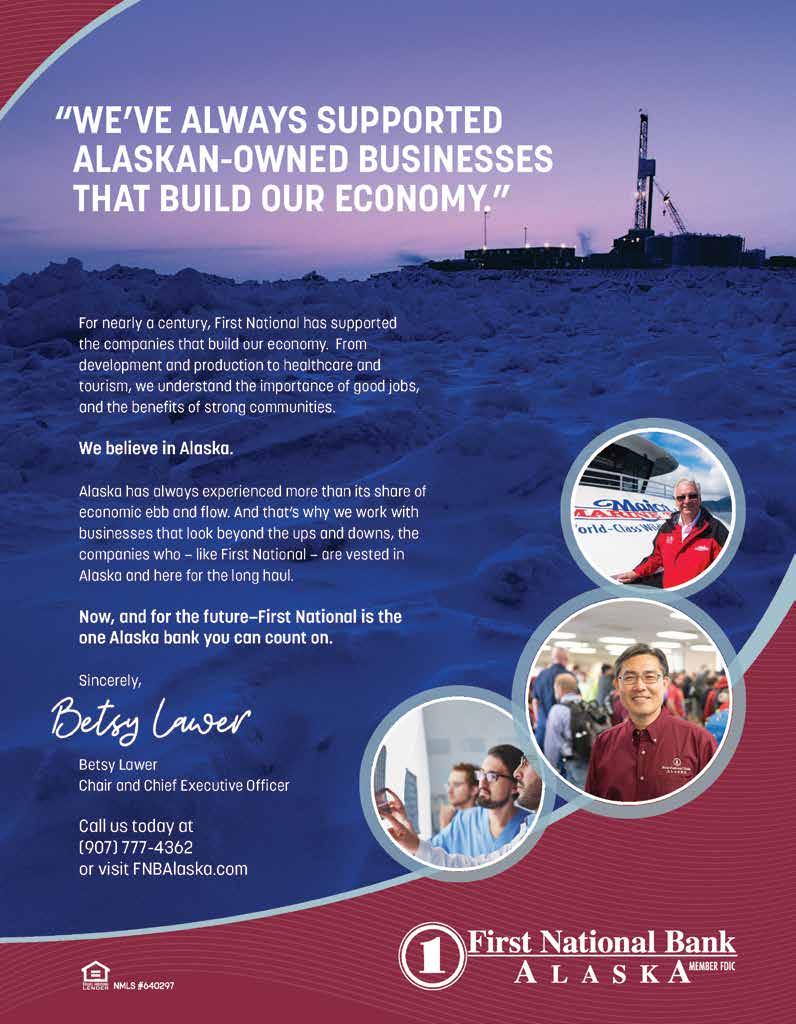
CONTENTS
SPECIAL SECTION: HEALTHCARE
44 SENIORS HAVE CHOICES
New options for assisted living in Anchorage
By Dimitra Lavrakas
54 A BATTLE OF NERVES Alaska clinics research new pain management methods
By Rachael Kvapil
60 WASTE AWAY
The unending chore of medical trash disposal
By Katie Pesznecker

48 AFFIRMING CARE Transgender healthcare resources in Alaska
By Scott Rhode
38 A HELPING HOOF (OR PAW) Therapy animals and human wellness
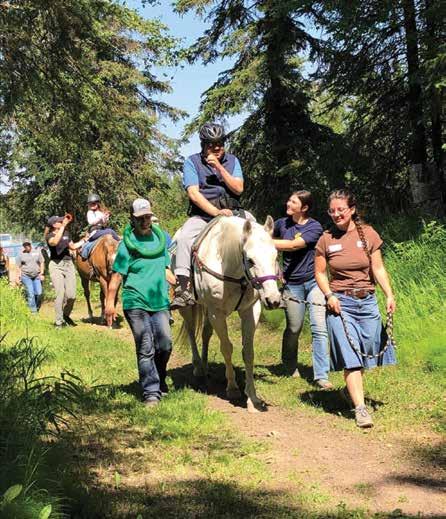 By Vanessa Orr
By Vanessa Orr
ABOUT THE COVER
Christy Constantini is the executive director of Equine Assisted Therapy Alaska (EATA), a nonprofit that helps improve the quality of life for persons of all ages living with physical, emotional, or cognitive disabilities. It’s telling that EATA provides online bios not only for its five staff and eight board members but also the program’s eight current horses, as well as several horse alumni. While everyone at the organization is there to help, it’s the horses that end up pulling most of the weight—physically and mentally. According to Constantini, “[The horses] can sense if you’re happy or sad, and they project their energy to help you feel better… I can’t explain it other than horses have an intuitive nature to humans, and they know what you need when you’re here.”
Cover Photo: Kerry Tasker | Monica Sterchi-Lowman
Alaska Business (ISSN 8756-4092) is published monthly by Alaska Business Publishing Co., Inc. 501 W. Northern Lights Boulevard, Suite 100, Anchorage, Alaska 99503-2577; Telephone: (907) 276-4373. © 2022 Alaska Business Publishing Co. All rights reserved. No part of this publication may be reproduced without written permission from the publisher. Alaska Business accepts no responsibility for unsolicited materials; they will not be returned unless accompanied by a stamped, self addressed envelope. One-year subscription is $39.95 and includes twelve issues (print + digital) and the annual Power List. Single issues of the Power List are $15 each. Single issues of Alaska Business are $4.99 each; $5.99 for the July & October issues. Send subscription orders and address changes to circulation@akbizmag.com. To order back issues ($9.99 each including postage) visit simplecirc.com/back_issues/alaska-business.
6 | December 2022 Alaska Business www.akbizmag.com
Equine Assisted Therapy Alaska
Determine Design
DECEMBER 2022 | VOLUME 38 | NUMBER 12 | AKBIZMAG.COM






202210-2462523
expenses,
Distributor/Underwriter.
restrictions
Save
the
An investment in a loved one's future education is a gift that can last a lifetime. And this year with the Dash to SaveTM incentive program, your gift can go even further. 1-888-4-ALASKA | Alaska529plan com SAVE IN ALASKA. STUDY ANYWHERE.
IS THE GREATEST GIFT THEY CAN RECEIVE.
There's still time to open a new account in 2022 and if eligible, Alaska 529 will pitch in a $250 contribution.* Get star ted with just $25.
Go online or call the number listed above to request a Plan Disclosure Document, which includes investment objectives, risks, fees,
and other information. You should read the Plan Disclosure Document carefully before investing. O ered by the Education Trust of Alaska. T. Rowe Price Investment Services, Inc.,
*Certain
apply; visit Alaska529plan.com/DashToSave for terms and conditions. Dash to
is a trademark of
Education Trust of Alaska.
EDUCATION
In October I attended the Alaska Travel Industry Association’s annual conference, this year held in Sitka. (Speaking of, if you haven’t been to Sitka, put it on your bucket list. It’s stunning.) This was the travel association’s first live convention since the onset of the COVID-19 pandemic. Like many other organizations, it has expanded its convention capabilities, creating a valuable experience for those able to attend in person while including those unable to make the trip through electronic conferencing.
That hybrid format allowed a wider array of guest speakers to share their insights at the event. I attended “Accessible Travel in Alaska,” a session featuring a panel that spoke about improving accessibility for guests who have specific mobility requirements. The four panelists, all of whom rely on medical devices to aid their movements while traveling, shared their experiences and advice via the internet.
I attended the panel primarily to get an idea of some sources to reach out to for a story we’re planning for our April 2023 issue. Since I framed my attention in that way, I missed that the message applies to our publishing business as much as any tourism-based enterprise.
Recently we were arranging a photoshoot for the magazine and proposed a specific location for the shoot to take place. The subject of the photoshoot asked why we chose the location we did. We explained our rationale, assuming the additional information would help the subject feel at ease. Instead, our subject explained that they would be unable to do a photoshoot at that location because it was inaccessible to them.
Immediately, I felt a pit in my stomach. Despite the fact that Art Director Monica SterchiLowman and I have been working for more than half a year to make our website more accessible, and despite the fact that I had attended this panel not even a month prior, we had both failed to recognize that we have never taken the time to check in, before finalizing the details of a photoshoot, to ask if our subject had any accessibility needs.
It’s not hard to ask. It costs us nothing. There’s no excuse.
It was a stunning oversight, and the only silver lining is that the lesson finally landed. Moving forward, we will do better.
Although we don’t specifically address accessibility in this issue, in our special section we have expanded our coverage of the healthcare industry to look at a bigger picture of what care may mean. Being healthy and well requires a range of services and providers, and those needs can change for individuals over their lifetime. No matter the nature of the need, health-related or otherwise, all people are an essential part of our communities and economies. We need to include them.
According to the Centers for Disease Control and Prevention, 26 percent of adults in the United States, which is approximately 61 million people, have some type of disability. Of those, 13.7 percent have challenges to their mobility; 5.9 percent to their hearing; and 4.6 percent to their vision.
Can your business afford to exclude a quarter of adults in the United States from your potential customer pool?
We know we can’t. The many costs of exclusion—to ourselves, our clients, our customers, and our community—are too high.
EDITORIAL STAFF
Managing Editor Tasha Anderson 907-257-2907 tanderson@akbizmag.com Editor/Staff Writer Scott Rhode 907-257-2902 srhode@akbizmag.com Social Media Carter Damaska 907-257-2910 enews@akbizmag.com Editorial Assistant Emily Olsen 907-257-2914 emily@akbizmag.com
PRODUCTION STAFF
Art Director Monica Sterchi-Lowman 907-257-2916 design@akbizmag.com
Design & Art Production Fulvia Caldei Lowe production@akbizmag.com Website Manager Taylor Sanders webmanager@akbizmag.com
Photo Contributor Kerry Tasker
BUSINESS STAFF
President Billie Martin
VP & General Manager Jason Martin 907-257-2905 jason@akbizmag.com VP Sales & Marketing Charles Bell 907-257-2909 cbell@akbizmag.com
Senior Account Manager Janis J. Plume 907-257-2917 janis@akbizmag.com
Senior Account Manager Christine Merki 907-257-2911 cmerki@akbizmag.com

Accounting Manager James Barnhill 907-257-2901 accounts@akbizmag.com
CONTACT
Press releases: press@akbizmag.com
Tasha Anderson Managing Editor, Alaska Business
Postmaster: Send address changes to Alaska Business 501 W. Northern Lights Blvd. #100 Anchorage, AK 99503

AKBusinessMonth
alaska-business-monthly AKBusinessMonth akbizmag
FROM THE EDITOR
VOLUME 38, #12
8 | December 2022 Alaska Business www.akbizmag.com



10 | December 2022 Alaska Business www.akbizmag.com TELECOM & TECH
Leveraging 5G

Faster, more stable, and more secure wireless connectivity
By Tracy Barbour
5G technology is having a significant impact at Spawn Ideas. The Anchorage-based advertising agency is operating in hybrid mode: employees work two days in the office and three days from home, with about one-third of them completely remote. Most of the company’s thirty employees take advantage of 5G wireless service to communicate with colleagues and clients across Alaska, Washington, Montana, Iowa, Oregon, and Washington, DC.
The availability of 5G makes hybrid and remote work more feasible for Spawn Ideas. It enables employees to have ubiquitous and secure connectivity. For example, many use a mobile phone as a WiFi hotspot for their laptop when conducting Zoom calls or doing other business away from the office. With 5G, they can work wherever they are, which is a huge advantage—and luxury, according to President and CEO Karen King. “We are really spoiled by 5G’s data transfer speeds,” King says. “We’re used to low latency. We’re used to the stability and reliability of having a 5G [compatible] phone and service.”
Spawn Ideas uses wireless service from GCI which, incidentally, is also a client of the agency. “Living in Anchorage, I feel that I have all of the advantages with service from GCI that anyone else has in other US locations,” King says, referring to the speed and dependability of 5G cellular service.
The use of 5G technology has been steadily increasing among consumers and companies like Spawn Ideas. By 2025, 5G networks are expected to have more than 1.7 billion subscribers globally, according to Global System for Mobile Communications, which represents the interests of mobile network operators worldwide. Most cellular carriers began ramping up their efforts to deploy 5G a few years ago. At this stage, 4G is still relevant because 5G networks and devices rely on 4G to enhance performance.
5G, the fifth generation of wireless technology, is the technological upgrade to the 4G networks that connect most current cell phones. 5G technology uses shorter, higherfrequency bands of the radio spectrum to deliver greater load capacity, faster speeds, lower latency (delay in transmission), and improved flexibility. The actual speed and range of 5G cellular signals varies according to where frequencies fall within the spectrum. Since 5G can run on any frequency of the airwaves, it allows telecommunications companies to deliver different 5G experiences to their customers. 5G can be implemented in low band—which uses a frequency range similar to 4G cellphones— or mid band or high band.
www.akbizmag.com Alaska Business December 2022 | 11
GCI
Being a relatively new technology, 5G continues to evolve with the development of networks and devices. As 5G got off the ground, the biggest limiting factor was device availability, according to Josh Lonn, vice president of wireless products at GCI. “Most networks launched without a customerready device to market, including GCI’s 5G network,” he says. “On the consumer side, we saw earlier support on the Android side, as we launched the S20 5G in mid-2020, followed by the 5G-capable iPhone 12 later that year. That device ecosystem has matured beautifully over the last couple of years, pushing 5G availability down to affordable levels for consumers. Our customers love those phones and know they are getting the best available service in Alaska.”
Applications and Implications
Many industries are just now pondering how they can best leverage 5G technology. Initial use cases involve “stranded” data where building a wired connection doesn’t make sense. Other applications include enhanced mobile workforce scenarios.
“5G for business is still early-days enough where it is tough to tease apart use cases that could just as effectively be served with a strong LTE [longterm evolution] network,” says Aaron Helmericks, senior director of energy and mining at GCI Business. “Over time, the buzzwords of today, like ‘network slicing’ and ‘ultra-reliable, low-latency communications’ will start to make more sense as the device ecosystem evolves and as the customer business cases sharpen. But, again, these services are an evolution over what we can already do—in some cases, on a more limited basis using LTE [which was the generation just before 4G].”
Helmericks says 5G isn’t as gamechanging for business in the way it has been for consumers. All that will change as the foundation grows stronger. “We’re in the third year of a ten-year curve,” he says. “Think of where LTE was in the third year of its evolution [circa 2012]: data rates were still what we’d consider to be in the yawner category today, and the industry was just starting to think about advanced LTE services like VoLTE [voice over LTE] and MIMO [multiple-input and multiple-output].”
method for multiplying the capacity of a radio link using multiple transmission and receiving antennas to exploit multipath propagation.
5G is still in the initial stage of development, Helmericks says. “That said, the next set of 5G enhancements coming down the roadmap will be focused on providing large enterprise businesses the next-generation wireless connectivity capabilities like enhanced security, network slicing, missioncritical, and edge compute,” he says.
AT&T describes 5G as the “most transformative wireless technology” yet, with huge potential to spark innovation in everything from transportation to entertainment. Businesses today need to think and operate differently—and 5G makes that possible, says Jason Inskeep, AVP of AT&T’s 5G Center of Excellence in Texas. “Compared to previous generations of wireless networks, 5G’s faster speeds and low latency are creating more opportunities for massive IoT and sensors connectivity, fueling innovation and digital transformation across all industries,” he says.
Although 5G requires upgraded cellular networks and devices capable of accessing the new networks, mobile providers are maintaining their 4G networks as they invest in 5G deployment. In addition, people who have 5G phones can expect them to work even where 5G service is limited because the 5G phones are backward compatible.
Jason
AVP of 5G Center of Excellence AT&T
VoLTE and MIMO are essential elements of wireless communication standards. VoLTE is an LTE high-speed wireless communication standard for mobile phones and data terminals, including internet of things (IoT) devices and wearables. And MIMO is a
How does 5G compare to the 4G service most people use? The Federal Communications Commission indicates that some 5G services will provide data speeds up to 100 times faster and almost instantaneous response time. For example, it can take almost six minutes to download a feature-length movie with 4G. With 5G, the same movie can download as quickly as 15 seconds. Technically, current 4G speeds are approximately 12 to 36 megabytes per second (Mbps), while 5G services are expected to support speeds of up to 300 Mbps or greater.
Aside from mobile applications, some telecom providers are offering broadband wireless as an alternative to wired connections, such as digital subscriber line, fiber, or cable services.
“Compared to previous generations of wireless networks, 5G’s faster speeds and low latency are creating more opportunities for massive IoT and sensors connectivity, fueling innovation and digital transformation across all industries.”
12 | December 2022 Alaska Business www.akbizmag.com
Inskeep
AT&T’s 5G Offerings
AT&T’s 5G network reaches more than 281 million people and nearly 22,000 cities and towns in the country while its wireless network covers more than 99 percent of Americans (based on overall coverage in US licensed areas).

The company delivers three “flavors” of 5G—low band, mid band, and high band—to give customers individualized experiences, faster speeds, and greater capacity. In Alaska, AT&T offers lowband 5G, which can travel farther than its high-band 5G+ and penetrate buildings and objects. Its lower-frequency waves are slower for data, but it’s practically impervious to distortion.
AT&T’s mid-band 5G+ (using C-band spectrum) is faster and more responsive for the most demanding apps and services, from gaming to streaming to video conferencing. It travels farther than AT&T high-band 5G+ and provides faster speeds than the low-band version. And AT&T’s high-band 5G+ (using millimeter wave spectrum) delivers super-fast speeds but has limited reach. It’s more prone
to distortion and is primarily employed in stadiums and high-traffic areas like entertainment venues.
According to Inskeep, companies large and small across all industries are transforming their business due to the impact of Industry 4.0, the oncoming (or ongoing) revolution involving massive IoT device proliferation and data intensive applications. “For example, AT&T is working with a company [whose name AT&T did not disclose] in Alaska to provide reliable and secure connectivity on the North Slope through a private wireless network,” Inskeep says. “Outdoor remote areas have dependency on connected devices, and WiFi can’t support all of the customer’s needs.”
AT&T’s 5G and private wireless networks serve the customer’s need. Inskeep explains, “With the private network, the company’s workers can access applications and IoT analytics and input information gathered in the field on their mobile devices, and the data stays private on the company’s local network. Before the installation of the private network, workers would have
 The stability and reliability of 5G phone and internet erase much of the inconvenience of working remotely.
The stability and reliability of 5G phone and internet erase much of the inconvenience of working remotely.
www.akbizmag.com Alaska Business December 2022 | 13
whyframestudio | istockphoto.com
| iStock
to make handwritten notes about their equipment inspections. The private network also can support cameras to monitor gauges and other equipment remotely, reducing the amount of trips workers must take to remote facilities in treacherous terrains.”
5G from GCI
GCI launched Alaska’s first 1 Gbps and 2 Gbps internet service as well as the first standards-based 5G new radio (NR) service in the Anchorage Bowl in 2020. Recently GCI expanded its 5G footprint across the MatanuskaSusitna Borough. “Together, these areas cover over half of Alaska’s population,” Lonn says. “We will continue to push 5G service into our other urban markets, like Fairbanks, Juneau, and Kenai.”
As its next major undertaking, GCI is working on 5G service on the North Slope. In doing so, 5G will provide the area with wireless network
connectivity to remote equipment, vehicles, inspection drones, mobile industrial IoT devices, and workers. GCI envisions improvements in productivity, efficiency, accuracy, and automation of intricate control processes at oil fields.
“We’re excited to bring 5G to the North Slope in 2023, bringing state-of-the-art connectivity to our enterprise partners in that area,” Lonn says.
In addition to expanding coverage, GCI has focused on improving the speed of its 5G service. When the company launched Hometown 5G, it lit up five bands of radio spectrum. “Think of all that added spectrum as brandnew lanes on a superhighway,” Lonn says. “Even with the strong subscriber growth we’ve seen since our upgrade, those competitive speed test results show that there is still plenty of room to cruise.”
Currently, GCI delivers 5G to customers in all fifty states through a partnership with T-Mobile. The GCI
5G network in Alaska and the T-Mobile network that GCI customers have access to run on low band (600 MHz) spectrum. With GCI and T-Mobile’s low-band signal, information can still transmit at a rapid rate and travel through walls and buildings.
GCI says its 5G network provides bandwidth secure enough to support all unified communications and operational platforms for businesses, and the company sells a variety of 5G devices. These offerings from GCI allow consumers to leverage the latest 5G technology for their current and future needs. “Any customer that buys a 5G product or buys into Alaska’s most advanced network will be experiencing the best possible wireless connectivity in the state,” Lonn says. “Remember that where we are now is not how the 5G technology will perform in several years, and we haven’t even thought of the use cases that will revolutionize wireless connectivity.”
 Downtown Fairbanks is next in line for 5G service, after GCI furnishes the North Slope so that industrial users have access to the technology now in place in Anchorage and the Mat-Su Borough.
Downtown Fairbanks is next in line for 5G service, after GCI furnishes the North Slope so that industrial users have access to the technology now in place in Anchorage and the Mat-Su Borough.
14 | December 2022 Alaska Business www.akbizmag.com
Christine_Kohler
Construction of Span Alaska’s new Fairbanks Service Center (FSC) is underway, but it is breaking ground in more ways than one. Our FSC will be one of the most technologically modern, efficient, and purpose-driven transportation facilities ever built in Fairbanks.
Coming in the summer of 2023, Span’s FSC will increase our capacity, improve security, offer customizable storage areas, and streamline freight handling — all to ensure faster, smoother, and more consistent delivery of your product to its final destination.



To schedule a pickup or find the Span location nearest you, call 1-800-257-7726 or visit us at spanalaska.com.















Serving Alaska since 1978






























The Video Frontier
Alaskans stake claims in YouTube gold rush
 By Vanessa Orr
By Vanessa Orr
You were TIME magazine’s Person of the Year for 2006, thanks to a certain tube first established one year earlier. YouTube was one of several platforms from the early ‘00s that enabled, encouraged, and even demanded users to generate their own internet content. The video hosting service, acquired by Google a few months before TIME’s mirrorreflective cover, gave “you” a way to broadcast globally—and Alaskans have used its tools to bring their home state to viewers worldwide.
YouTube makes uploading videos easy, but counting on the platform for income is as strenuous as any job.
“I know some people who make good money on the platform, but they work harder than everyone else,” says Jake, creator of the channel How to Alaska. “It’s one of those jobs that people look at and idolize those doing it, but what
they don’t recognize is just how much work goes into putting out good videos and content and how much of a grind it can be. It doesn’t come easy.”
Another Jake, Alaskan videographer and photographer Jake Sloan, learned the same lesson after three and a half years on YouTube.
“It has taken a lot of work with almost no payoff until this last year. I did it every single week for three years without getting revenue and views to get where I am now,” Sloan says. “People think it’s easy: they post videos, and in six months, they have 100,000 followers. But it takes a lot of investment up front.”
Sloan recalls how reality set in during his early grind. “Those first three years, I would spend a day filming, a day editing and posting, and then waiting for people to watch,” he says with a laugh. “I might get three views—me watching it twice, and one from my mom.”
16 | December 2022 Alaska Business www.akbizmag.com MEDIA & ARTS
John Derting
The Guy Who Stands on Glaciers

Sloan’s latest video (as of publication) racked up 535 views in its first day; the one before that tallied 24,000 in five days. His record is 616,000 views. More than 78,000 subscribers await each new upload on his eponymous channel. Sloan’s videos are, in a way, metavideos geared toward helping other creators make their own content, such as reviews of filmmaking equipment, tutorials, and storytelling advice.
“What got me started was recording adventures with myself and my kids for our memories, and then I purchased a drone and posted something about that, and it got a lot of views,” he explains. “That got me looking at the whole idea of the business model behind YouTube and how random people on the internet finding videos that you post can lead to bigger things down the road.”
Sloan committed to posting one video each week three-and-a-half years ago, and his page has continued to grow.



“When I started in this niche it was a pretty crowded space, but what set me apart is Alaska and having access to so many incredible locations and insane backdrops,” he says. “I started focusing on going out to make videos in the wild, compared to what I was doing before which was sitting at a desk, doing ‘scientific’ equipment tests like so many other people.”
When COVID-19 hit, his channel grew even more quickly as people were looking to experience something other than being in the house while the country was locked down.

While drone and camera enthusiasts make up most of his audience, Sloan acknowledges that he has earned a reputation as “the guy who stands on glaciers and shows off ridiculous locations to see how well a camera can take photos.”
“A lot of people comment that they don’t care about the equipment, but they love the places I go,” says Sloan. “That makes me happy because I think that Alaska is a pretty awesome place.”
Nutty Like a Fox
Nu Xiong, known as NuttyNu on YouTube, started posting “random” videos in 2011, including videos of

motorcycle and camping trips and time spent with his family.
“At first, YouTube was just a platform to upload videos; it was never my intention to start a channel,” explains Xiong, “but I realized that I really liked sharing my videos with everyone. While I enjoy filming the videos, that’s what really keeps the fire going.”
In 2016, he started cranking out more content, and now his 35,000 subscribers follow his lifestyle videos featuring hobbies and family, as well as some professional video that he
uploads to showcase his work as the owner of NuttyNu Media.


Alaska plays a big part in Xiong’s videos, showing up in about 90 percent of them. “People want to see what’s going on up here,” he says, estimating that about 70 percent of his subscribers come for entertainment and 30 percent watch for the knowledge he provides in tutorials and how-to videos.
“The biggest challenge is finding the time to make videos,” he adds. “Two years ago when I didn’t have my first child, I had all the time in the world to
ASM Global is the world’s leading producer of entertainment experiences. It is the global leader in venue and event strategy and management – delivering locally tailored solutions and cutting-edge technologies to achieve maximum results for venue owners. The company’s elite venue network spans five continents, with a portfolio of more than 350 of the world’s most prestigious arenas, stadiums, convention, and exhibition centers, and performing arts venues. Events | Concerts | Conferences | Conventions Banquets | Meetings | Trade Shows | Weddings In-house Catering | Equipment Technology Anchorage Convention Centers 907.263.2850 Anchorageconventioncenters.com Your space for any occasion Let’s get together www.akbizmag.com Alaska Business December 2022 | 17
Cars are one of Nu Xiong’s interests, so they feature in several playlists on his NuttyNu channel.

produce content. Now with my first kid and a second on the way, I have to find a way to balance between the work, my platform, and everything else with only 24 hours in a day.”
Xiong tries to post daily, or at least four to five videos per week.
“When I first started, I didn’t think about how to film things; now I plan ahead to know what the introduction, middle, and ending will be,” he says. “It’s something I wish I had learned earlier, but you learn as you grow and do more.
“Once you get the idea of what you like and what your audience likes, you can get a better idea of the workflow,” he adds. “Now it’s almost automatic for me; I know what I’m going to create, and I film it with the editing process in mind. That speeds it up.”
Alaska as a Verb
Editing is the bottleneck for How to Alaska. “I try to get out and do something cool that I can share once a week, but editing is my least favorite part. It’s a chore for me and slows me down,” says Jake. “I try to post content weekly, but I have gone a couple months between posts. If I were more consistent, I’d probably be further along.”
Jake (last name withheld) works as a full-time real estate and drone photographer in Southcentral Alaska, squeezing in YouTube videos around that schedule. “Having an excuse to get my family outdoors and being able to show people Alaska really motivates me,” he says. “The editing and time factor, and having another job alongside of YouTube, is a challenge though.”
Jake’s videos center on his family’s outdoor adventures, so he chooses to keep his last name unlisted for his children’s privacy. He got the idea for the channel when his friend Lonnie’s
page, Far North Bushcraft and Survival, reached 30,000 subscribers.
“When I found out that YouTube would start paying you when you reached that point, I thought it would be a good hobby income, and I’d do a good job of it,” he says. “It’s a lot of work, but our family loves to spend time outdoors, and we’ve always enjoyed sharing Alaska with others.”

Where the Money Is
Nobody can predict what will catch fire on YouTube. For instance, NuttyNu’s most popular video, with 3 million views, is a 30-second close-up of lips covered with glittery lipstick, titled “LIP.” Who knows why?
Sloan researched YouTube to determine where success might lie. “It took me a long time to figure it out; it was so far out of my wheelhouse,” he says. “I had to dig through a lot of different information to figure out how to monetize my content.”
He found that financial videos have the highest ad revenue and affiliate income of any videos in the online market space, but anyone producing kids' or entertainment videos can face drastically different ad revenues. While Sloan considers his YouTube videos to be a side hustle to his full-time job of drone filming for national TV shows and movies, he does make a decent return.
Jake has been making YouTube videos since 2014, and How to Alaska has grown to more than 42,000 subscribers. Lately his content has focused on short videos formatted for mobile screens, which are more liable to go viral. “What You Can Catch Surf Fishing in Alaska,” a 30-second snippet posted in early October, scored 53,000 views within two weeks. The channel’s most popular video, “Launching Cars Off a Cliff for 4th of July,” has been viewed 6.4 million times in five years. Not bad for a 7-minute slice of Alaska life.

“Most people with under 100,000 subscribers in my niche probably make in the $30,000 to $40,000 range, though that varies wildly depending on the niche that someone is in and the views that they get on every video,” he explains. “Because all online advertising is targeted, a creator’s niche varies greatly on how much ad spots pay out.”
How to Alaska’s how-to advice for succeeding at YouTube also relies on a calculated approach. “You have to allocate time properly and figure out quickly how to get the best bang for your buck, as well as what will resonate the best for your audience,” Jake says.
Instead of chasing trends, though, Xiong prefers to follow his own muse: “If you put your attention on that and you love what you’re doing, the subscribers, money, and ads will follow.”
Alaskan living is the biggest asset local YouTubers have to share, so Jake and his family tapped into that audience. How To Alaska
18 | December 2022 Alaska Business www.akbizmag.com
NuttyNu
Cashing In on Clicks

Sloan’s videos have led to solicitations for other jobs. “My work for Caterpillar, Bell Helicopters, and the Chicago P.D. show came from me posting videos on YouTube,” he says. “It’s another way the online distribution market space can be monetized.”

More direct avenues for YouTube creators to monetize content include ad sales, affiliate sales, sponsored posts, or selling digital courses online.
“The key to being successful on YouTube is to have multiple streams of income,” says Sloan, who profits from ads sold in the middle or at the end of his videos and from affiliate sales, for which he makes 3 to 5 percent from any products sold through the link on his website. He also provides a digital sales course teaching people how to fly drones, and he hosts sponsored videos, where a company pays him to make a certain type of video.

“In some cases, they pay for me to just go do something awesome,” says Sloan, who filmed inside an ice cave at Castner Glacier, north of Paxson, which was sponsored by a company that makes film emulation software.
How to Alaska’s Jake appreciates YouTube’s streamlined system for monetizing and sharing content.





“You can start making money on YouTube when you get 1,000 subscribers and 4,000 watch hours. That allows you to apply for their partnership program,” he says. “If you’re not doing shock content or anything overly political, it’s pretty much a given that they’ll accept you.”



Once established, creators split ad revenue 55/45 with YouTube. “The longer the content is, the more ads can be put into it; a two-minute video may have one ad and a 30-minute video will have twelve,” says Jake.

Creators can also take part in Super Chats, where people send creators money to push their channel along, which they split 70/30 with YouTube. Content creators get the same split when they produce live videos.

“They are talking about rolling out a new way of monetizing called YouTube Shorts that they will use to try to compete with TikTok,” says Jake. “They’ve been working out the bugs for a couple of years and may introduce it at the beginning of the




year. Creators will split the ad revenue 55/45 with YouTube.”



NuttyNu makes income through affiliate links, including Amazon, as well as through the Google AdSense link, which helps Xiong monetize his platform. That seems secondary, though, to simply sharing life in Alaska.



The view outside his window is what Nu Xiong’s YouTube channel presents to the world.
“I never had a numbers goal; I just thought it would be nice to get 1,000 subscribers,” Xiong says. “When I got to 10,000, I stopped worrying about it. I started focusing more on creating the content that I wanted to create.”

COMING TOGETHER IN RHYTHM JOIN THE CHORUS AND FIND YOUR CAREER WITH CHUGACH. chugach.com/careers www.akbizmag.com Alaska Business December 2022 | 19
NuttyNu
Unpacking an Underdog
PacBak is headed upstream to national markets
By Dan Kreilkamp
Not many startups can claim they outshone the likes of Garmin and YETI on one of the biggest stages in outdoor retail. Even fewer can say the original design for their award-winning product was first etched on the back of a urine test, now framed and hung proudly next to its patent.
The buzz that comes with winning “Best of Show” at the world’s largest sportfishing convention only highlights the already incredible story of PacBak and Brian McKinnon, which serves as inspiration for other underdog entrepreneurs looking to forge their path in Alaska.
When he isn’t developing products, the Wasilla native spends his time fishing, hunting, and exploring the rivers and lakes he calls home. The inspiration for this most recent invention, a top-of-the line cooler and mobile kitchen equipped with a first-of-its-kind rechargeable battery-operated vacuum sealer, came to him like any other.
“All of my inventions and everything that I’ve brought to fruition have been out of necessity, never desperation,” says McKinnon. “It was always something like, ‘How does this not exist?’ or, ‘Why isn’t this better?”

20 | December 2022 Alaska Business www.akbizmag.com MANUFACTURING PacBak
Loves Fishing, Hates the Rest of It
The development of the P88-MK Cooler/ROAM 18-V Vacuum Sealer Combo has been nearly a decade in the making, first taking the shape of a backpack which incorporated an early prototype for his battery-operated vacuum sealer that McKinnon lugged during his fishing expeditions.
“My brother says he loves fishing; I say I love catching,” McKinnon jokes.
As any angler knows, catching is only a small part of the experience. Most of fishing is the hours spent preparing or waiting and then—eventually, after a long day on the river and a long drive home—the processing.
“You’re tired, you’ve been on the boat all day, your hand hurts from stripping line, retying hooks, and then you pull your boat in and it’s like, ‘Oh my god… I have to vacuum seal all of this fish,” he says with a laugh.
Labor was only part of reason McKinnon knew the world needed a more functional cooler. The more important piece, McKinnon says, is the taste.
Growing up on the water, his family would often pluck a fish from the river, filet it on the spot, and plop it on the grill. “It was such a different taste that I realized not a lot of people were able to experience. Fish deteriorates every hour it’s out of water,” he says. “Salmon is actually sweet; it tastes sweet, it smells sweet when it first comes out. The taste is just incredible, and I’ve always wanted to trap that in.”
Before the P-88 MK/ROAM Combo began stealing the show, McKinnon enjoyed varying degrees of success with a handful of other inventions inspired by and designed for the Alaska experience.
The world’s first aluminum personal watercraft, AlumaSki, was McKinnon’s way of navigating the state’s shallow streams and creeks. A safer industrial fueling system for truckers was his first stab at product design, conceived during one of his stints as a laborer on the North Slope. Some designs were more successful than others, but with the P-88 MK and ROAM 18-V, McKinnon appears to have found his golden goose.
When he first heard about the International Convention of Allied Sportfishing Trades (ICAST)—the event in July that PacBak took by storm—the application window had already closed. He had to track down the event’s vice president, Blake Swango.
“We pretty much begged them to let us in,” McKinnon says, laughing. He stressed how difficult it was, as an Alaska-based company, to meet retailers.


“What am I going to do?” he recalls pleading with Swango. “Win the thing or something?”
Swango eventually caved, allowing McKinnon’s team to set up a small booth “all the way in the back” at the Orange County Convention Center in Orlando, Florida.
And the rest is history.
After the longshot win at ICAST, discussions for lucrative contracts with major retailers began rolling in. Only moments before the interview for this article, McKinnon’s team wrapped up a call with Walmart.
PacBak’s first nationwide distribution contract places his award-winning

THE SOLUTIONS COMPANY Full facility removal, asbestos, remediation, waste management, demolition and site work www.akbizmag.com Alaska Business December 2022 | 21
cooler in Army Air Force Exchange Stores, in gratitude to military veterans who invited McKinnon into their support group during his time of need.

Peaks and Valleys
Over the last decade, McKinnon has endured a series of unexpected deaths—thirty-two friends by his count, eighteen of whom died in his presence.
The most traumatic, he recalls, was in October of 2017, while attending a concert in Las Vegas with his close friend Adrian Murfitt.
On the final night of the Route 91 Harvest music festival, a shooter in the Mandalay Bay hotel fired down on the crowd of 22,000, striking Murfitt in the neck. Murfitt was one of two Alaskans killed out of fifty-eight total fatalities that day.
The trip was supposed to serve as a sort of pick-me-up for McKinnon, but instead it proved a catalyst for a downward mental spiral.
“It just really flipped things over. I couldn’t go out in public. I was seeing things, hearing things. It was really bad,” he recalls. Although he refused to use the pharmaceuticals prescribed for his shoulder surgery—McKinnon sustained his own injuries during the shooting— he instead turned to alcohol.
“It got to a point where the sounds and visuals and episodes got so bad that I was just drinking vodka on the couch and sleeping for like three, four days at a time,” he says. “And I was doing it just to not be awake, you know?”
Months of anxiety, substance abuse, and homelessness followed, until one day McKinnon decided he’d had enough. The morning of November 30, 2018, he washed those previously neglected painkillers down with some vodka.
Within a half hour, though, a magnitude 7.1 earthquake hit the Anchorage area. The owner of the building where McKinnon was sleeping checked for damage and found him in time to intervene.
The first thing he did after the episode, McKinnon says, was promise his children that he would make something of himself and that he wouldn’t stop until he did.
A friend connected him with a trucking job on the Slope, one that he was probably overqualified for

22 | December 2022 Alaska Business www.akbizmag.com
PacBak’s P88-MK Cooler/ROAM 18-V
Vacuum Sealer Combo is a 60-pound box containing all the rugged features that designer Brian McKinnon always wanted while fishing around Wasilla.
PacBak
but was in no position to turn down. He found success in the role and then again in another, steadily rebuilding his life and reputation.
McKinnon reignited his vision for PacBak during his downtime on the Slope, citing it as his reason to persevere. With a portion of each paycheck, he was able to fund his product development and eventually secure the necessary patent and molds.
While he enjoyed a great deal of emotional support from friends and family, the same can’t quite be said financially.
“When I was starting out, no one wanted anything to do with me,” he says of his struggle to attract investors. “We have a small community, and when you end up that low, people notice. I wasn’t in a situation where I could speed this up. I had to pay for it paycheck to paycheck, and that’s really how it had to go.”
At one point, McKinnon offered a friend 30 percent equity in exchange for a $30,000 investment. Fortunately that friend didn’t bite, as PacBak’s projected valuation grows each day,
having already exceeded an eightfigure sum.
The company’s financial path didn’t truly materialize until a different friend of McKinnon’s, Randee Johnson, introduced him to her colleague from college. It didn’t take long for Johnson’s colleague, Jac Arbour, to recognize the potential in both McKinnon and his product—even going so far as to join the venture as PacBak’s first investor and CEO.
The Most Important Number
Before being mentored by renowned business coaches, before growing his financial management company in Maine and Arizona, Arbour was preparing for a career in medicine. This seems fitting, as surgical is an apt descriptor for PacBak’s laserfocused CEO.
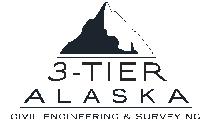
Borrowing a line from one of those coaches, Arbour says there are three factors that determine whether he would do business with someone:
The first is trust. The second is trust. And third (you guessed it) is trust. McKinnon ticked those boxes.
“The way he carries himself, the way he speaks, his cadence, his patience— he’s obviously been through a lot,” Arbour says. “The fact that he’s alive, the fact that he’s as mentally strong as he is after having been through what he’s been through… his heart is in the right place.”
Of course, as someone who assesses dozens of business opportunities each week, there were other considerations as well.
“Because of the position that I’m in, you learn to say ‘no’ to a lot of potentially good ideas,” Arbour continues. “You know that you could say ‘no’ for five years to a lot of deals that might do okay, and you just wait for one really great one to come along.”

In McKinnon, Arbour also recognized someone with a complementary skill and similar goal set. The feeling was mutual, and this understanding was central to their early discussions regarding PacBak’s division of labor.
“I said, ‘Brian, in an ideal world, from everything I know about you, we should get everything off your plate except being the face of the company
SURVEY / CIVIL SERVICES








ENVIRONMENTAL SERVICES

- SURVEY
3-Tier Alaska has merged with Travis/Peterson Environmental Consulting, Inc.
CIVIL
- ENVIRONMENTAL
As-built Plot Plans • Boundary Surveys Road Alignments • Grading Design Construction • Surveying Earthwork Quantities/Cross Sections Cadastral Remote Parcel Surveying Landscaping & Drainage Design Water Sample Testing & Analylis Septic System Design & Testing Percolation & Sample Analysis Commercial Site Development Subdivision Design & Platting Right of Way/Easements
NEPA Compliance Audits & Permitting Storm Water Pollution Prevention Plans (SWPPP) Wetlands Delineation & Mapping Environmental Site Assessments Environmental Impact Statements Permitting & Regulatory Compliance Wetlands Jurisdictional Determination Report Wastewater Treatment System Design & Permitting Drinking & Storm Water System Design & Permitting Spill Prevention, Response & Site Remediation Spill Prevention Control & Countermeasure Plans (SPCC) 3tieralaska.com I tpeci.com 326 Driveway St. Suite 102 • Fairbanks AK 99701 • 907-451-7411 329 2nd Street • Fairbanks AK 99701 • 907-456-5895 3305 Arctic Blvd, Suite 102 • Anchorage, AK 99503 www.akbizmag.com Alaska Business December 2022 | 23
and chief innovation officer. You’re a creative mind, you want to work with your hands, you want to design product—we need to get everything else off your plate so that you can be the guy designing the next generation of PacBak products,” Arbour says.
The biggest risk when building a company from the ground up, Arbour explains, is execution risk. Finding the right people to help carry out their strategy was a step PacBak couldn’t afford to get wrong. “There are so many things to figure out, and you need to hire the right team,” says Arbour.
Those things include product design, developing a go-to-market strategy, overseas manufacturing, shipping, warehousing, distribution, logistics—the list goes on.
A core tenet practiced throughout the PacBak company is the MIND methodology, which doubles as a software platform and company philosophy.
Pioneered by Arbour’s strategic business coach, Lee Benson, the MIND methodology is concerned with a company’s most important number and drivers.
“The whole system is designed around three things,” Arbour says. “Number one is alignment. Is the work you’re doing in alignment with your most important number? Number two is drivers: are you doing the right work that drives that number? And three is accountability: is everybody on your team accountable and being held accountable for the work they’re supposed to do that drives the most important number?”
Arbour didn’t ever say what that number is for PacBak, but it would be fair to imagine it has a few zeros at the end of it.
The Last Cooler You’ll Ever Need (Seriously)
Currently, the PacBak team sits at a small but mighty eleven. The team was hand-picked from some of the biggest names in outdoor retail. Arbour says each of them was hired with a specific goal in mind: to help PacBak scale.
“The scalability of PacBak is unlike anything I’ve ever seen,” says Arbour. “This product is extremely well made. You could define it as being overengineered, which a lot of designers won’t do today because they want to
create something as cheap as possible to focus on profit margins.”
And it’s not just scalable in terms of sporting industries. Certain aspects of the P88-MK, like its ice retention and diverse utility, have piqued interest from military and medical sectors as well.
The 60-pound cooler combo features two major compartments for separating wet and dry products, plus a dedicated compartment for the vacuum sealer. It’s a big box, though it might not appear so big next to McKinnon, standing 6-foot-3 and nearly 300 pounds. McKinnon had to be instructed to stay out of pictures with the product so that customers aren’t shocked by its size when they see it in person.
Apart from its durability—which was certainly tested during its 24-hour stay with a 1,250-pound Kodiak brown bear named Izzy—another aspect of the cooler that supports its longevity is the vacuum sealer’s use of replaceable heat strips.
Despite merchandisers advising the company against this, Arbour says this feature was never a question.
“If we wanted to focus solely on corporate profits, we would not have replaceable heat strips,” Arbour states. This design feature saves customers from shelling out more than $200 on a new vacuum sealer, instead spending $15 for a replacement part.
By extending longevity, Arbour says the company is keeping less plastic from landfills, and less petroleum is needed for manufacture.
Eventually, McKinnon and Arbour would like to see 100 percent of PacBak’s sealers and coolers made in America with recycled plastic waste from the oceans. While an ambitious goal, PacBak might be able to walk the walk.
This a product that enables users to process fish on the spot, replenishing Alaska’s rivers with nutrients from carcasses that anglers might otherwise carry home and toss in the trash.
Everything the company does, from product design to placement, speaks to a sustainable business model. Reflecting on what PacBak customers’ purchasing decisions might say about them, Arbour says, “If you buy PacBak, it's because you're a badass outdoorsman who supports entrepreneurship and
24 | December 2022 Alaska Business www.akbizmag.com
humanitarianism.”
“The scalability of PacBak is unlike anything I’ve ever seen… This product is extremely well made. You could define it as being over-engineered, which a lot of designers won’t do today because they want to create something as cheap as possible to focus on profit margins.”
Jac Arbour CEO PacBak
Build resistance against cyberattacks





Call 855-735-0890 to learn more or visit us at https://www.business.att.com/portfolios/cybersecurity.html ©2022 AT&T Intellectual Property. All Rights Reserved. Organizations need protection from more than ransom payment threats. Proactive detection and response limit the risk from cybersecurity attacks on your company’s infrastructure and build a dependable defense system against vulnerabilities. AT&T provides organizations with versatile and reliable coverage through efficient consulting and network security management.
Profit in Charity
How businesses partnering with nonprofits helps everyone’s bottom line
 By Tara O’Hanley
By Tara O’Hanley
Sixty-six years ago, a group of eighteen business leaders created the United Good Neighbor Fund, forming a board of directors that is now known as United Way of Anchorage. This early partnership between business leaders and nonprofit community-building organizations set the stage for a symbiotic relationship that continues to benefit the state.
“I think we all know what community we want to live in, and for our businesses, where they want their staff to be able to live, where they want their children to grow up,” explains Clark Halvorson, president and CEO of United Way of Anchorage. “Partnering with businesses to help create that community… doesn’t just help the folks who live there. It also helps the businesses and their ability to recruit and retain really great employees.”
26 | December 2022 Alaska Business www.akbizmag.com NONPROFIT

www.akbizmag.com Alaska Business December 2022 | 27
Big Brothers Big Sisters
United Way entered into one of its longest-lasting partnerships almost fifty years ago with the entity that became Alyeska Pipeline Service Company. “Their wanting and willingness to give back to the community is almost hardwired into the DNA of the organization,” according to Halvorson, whose staff recently provided Alyeska with photos from the earliest teaming events for the thennascent organization.
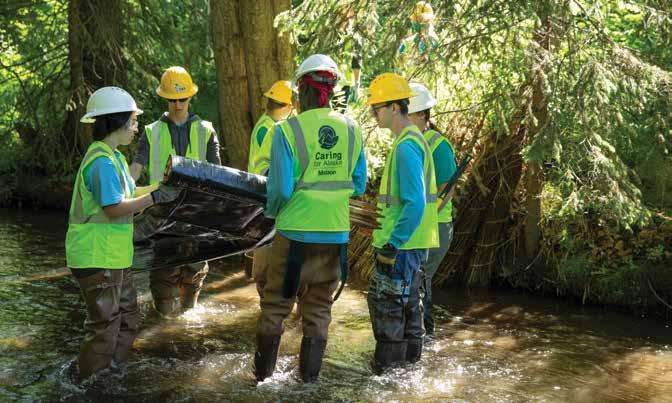
In the same way they have built up essential infrastructure, many of the largest organizations in Alaska have helped to weave a social network
to support people across the state. ConocoPhillips Alaska has “been an amazing partner” to the United Way of Anchorage, according to Halvorson, providing “years and years and over a million dollars invested into the United Way initiatives and our food drives.” He cites the Alaska Railroad Corporation as another company that’s been giving back to the community for over a hundred years, creating lasting change.
Alaska’s legacy corporations were far ahead of the curve when it comes to nonprofit partnerships, now recognized as a powerful strategy for business development.
Relationshipping
Since entering the Alaska market through acquiring Horizon Lines in 2015, shipping company Matson has invested millions of dollars in funding and in-kind services across the state. “One of Matson’s long-held values is a deep commitment to improving the quality of life and communities that we serve and making sure that we’re a good neighbor,” says Dylan Faber, Matson’s government and community affairs manager for Alaska. “When communities are a better place, employees are happier, they’re proud to work for Matson, and they’re proud
 Matson's Caring for Alaska program supports creek cleanups in Anchorage (above), and the company donates its shipping services to haul out recyclable materials (below).
Matson's Caring for Alaska program supports creek cleanups in Anchorage (above), and the company donates its shipping services to haul out recyclable materials (below).
28 | December 2022 Alaska Business www.akbizmag.com
Matson
Chris Arend | Matson
to be out there making a difference beyond just the essential role they play Alaska’s supply chain. Making the community a better place to live, work, and play for everybody is the greatest benefit we receive out of it.”




Through the Matson Giving Program, the company has donated shipping services for an ambulance to Anchorage, stadium seating for the Alaska Goldpanners baseball team in Fairbanks, pumpkins to Kodiak for 4-H’s largest annual fundraiser, furniture and a training simulation module to Covenant House Alaska, wreaths to Joint Base Elmendorf-Richardson, and timely supplies for the Alaska SeaLife Center. Matson also directly invested in the Food Bank of Alaska’s new warehouse.
In addition to moving literal tons of goods to and within Alaska, Matson also makes a big impact by donating southbound shipping. The biggest in-kind shipment each year comes through a partnership with Alaskans for Litter Prevention and Recycling (ALPAR), transporting up to 500 loads of recyclable material from Anchorage to Tacoma at no charge. According to Faber, “Without that service and shipping companies partnering with [ALPAR], it wouldn’t be financially feasible for recycling to happen in Alaska.”



Environmental causes are a natural fit for Matson. “We’re an ocean shipping company that serves some of the most pristine environments in the world,” Faber says. “We have a deep, deep commitment to making sure that those pristine environments stay that way.”
Through its Caring for Alaska program, Matson solicits proposals for projects that demonstrate environmental stewardship. Faber explains, “Nonprofits submit their request via our website, and then the regional giving committee, composed of employees, reviews those requests to determine how they impact the community, what the greatest needs are, and how the proposed project aligns with Matson’s giving priorities.”
The Caring for Alaska program has funded removal of invasive species, youth employment in parks, and a partnership with the Anchorage Waterways Council that brings hundreds of volunteers together to clean up dozens of creeks around Anchorage each year. “As members of
907-561-8922 www.greatoriginals.com 360 E. International Airport Road Anchorage, Alaska Customer Service Hours: 9am - 5pm, Monday - Friday Produ ction Ho urs: Till the work is done, as we promised! If it requires printing of any type, quick & reliable local production, email us for an quick Estimate at greatos@alaskan.com. www.akbizmag.com Alaska Business December 2022 | 29
the community, we want to do our part to help make it better,” says Faber.
Identifying Company Values
In selecting a nonprofit to partner with, corporations have an opportunity to reflect on their own values. “There’s so many different ways to involve businesses,” says Jill Richardson, CEO of Big Brothers Big Sisters of Alaska (BBBS), “but it’s just about growing relationships and hearing about what matters to the various people around the table, and then finding the alignment. With businesses, it’s a win/ win, to be honest.”
Nonprofits win with robust support from for-profit partners, of course, and Richardson sees benefits flowing the other way. “Companies that put that sort of purpose at the heart of business are more desired and more trusted, and their employees are more motivated and loyal,” Richardson says. “It has such a positive impact on people that when their employer helps support them to volunteer, I think they will attach those positive feelings to their employer. And there’s arguably not been a more difficult time to find and
keep good employees. So that kind of partnership should be prioritized now more than ever.”
Partnering with nonprofits can also help businesses gain clarity on what kinds of positive impacts they want to make. “We work with the businesses a lot on helping them engage their employees and identify what are those issues that they’re most passionate about,” Halvorson explains.
For instance, approximately fifteen years ago United Way leadership sat down with ConocoPhillips and heard about challenges in Alaska’s education system, especially in the areas of inequity. Out of this sprung the “90 by 2020” effort to raise graduation rates in Anchorage “and get it as close to 90 percent as we can,” according to Halvorson. “It was an area where we knew what the organization was passionate about. We were then able to go in with our campaigns and give them some data to show that we got to 88.1 percent on the graduation rate, and we were able to distribute almost 100,000 books to kids in Anchorage so that they’re better prepared to go back to school and learn.”
In maintaining close relationships with community leaders, United Way and other organizations also have an improved opportunity to respond when unexpected crises threaten the wellbeing of the community at large. Halvorson continues, “When we saw the impact of the pandemic, one of the biggest things that people were challenged with was, can they stay in their home? Can they heat their home? And John Sims, the president of ENSTAR, stepped in and said, ‘Hey, I want to have an impact on this.’ He stepped up to be our community campaign chair, which is amazing. He is helping us run the campaign and also set up the campaign that we did called ‘Warm Hearts, Warm Homes,’ to make sure that we could get people heating oil.”
The work of United Way of Anchorage has a significant impact on other areas of the state, as well. Its 211 helpline handled 40,000 calls last year, answering questions that ran the gamut from how to find childcare to how to find rent, so callers wouldn’t lose their homes.

Similarly, United Way’s healthcare
 Participating in the Anchorage Chamber of Commerce citywide cleanup puts Matson’s logo in a positive light, in addition to tidying up the community where the company’s employees live.
Participating in the Anchorage Chamber of Commerce citywide cleanup puts Matson’s logo in a positive light, in addition to tidying up the community where the company’s employees live.
30 | December 2022 Alaska Business www.akbizmag.com
Wayde Carroll | Matson
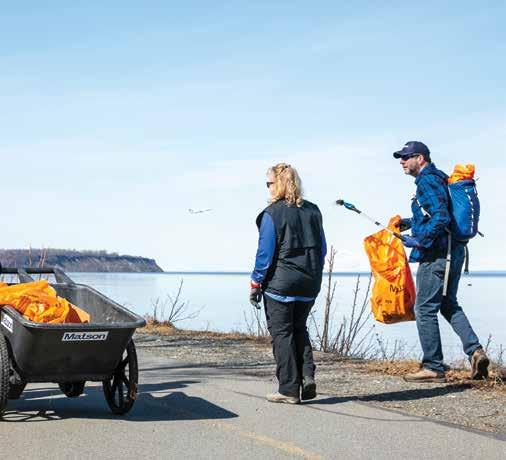















































“Partnering with businesses… doesn’t just help the folks who live there. It also helps the businesses and their ability to recruit and retain really great employees.”
STEP INTO ALASKA’S FUTURE WITH eCAMPUS Contact Teresa Thompson to get started: tathompson2@alaska.edu 907.455.2090 Encourage your employees to complete their degree or certification - all online! UAF eCampus Business Partnerships offer discounts. UAF is an AA/EO employer and educational institution and prohibits illegal discrimination against any individual. ecampus.uaf.edu eCampus www.akbizmag.com Alaska Business December 2022 | 31
Clark Halvorson President and CEO United Way of Anchorage
navigation program helped 1,700 uninsured Alaskans get coverage.
Helping Hands
Thinking of ways that businesses can’t partner with nonprofits is almost easier than listing the different ways they can help. “The thing I’m trying to do as an organization is have a multiple pronged approach to partnering with businesses,” says Richardson.
BBBS accepts direct financial support, naturally, and opportunities for volunteering are varied. “That’s anywhere from board members to volunteers who are at the heart of what we do,” Richardson says. “And then businesses can also sponsor some of the activities that we do.”
For more than forty years in Alaska, BBBS has been recognized as one of the most effective youth development programs in the United States, according to bethechange907.org. BBBS of Alaska reports that 88 percent of youth participants experienced improved academic performance after spending time with a caring adult, and 93 percent reported that they avoided risky activities as a result of their involvement.
The benefit appears to be reciprocal for the mentors. “I can’t tell you the number of ‘Bigs’ [BBBS’ moniker for adult volunteers] that tell me the relationship changed their life. I want to say it’s almost unanimous,” Richardson says. “That’s why I think a business might be inclined to want to support their staff to do work like this, because their staff might come back more engaged and happier.”
Still, BBBS wants to do more. With approximately 40 percent of “Littles” in BBBS self-identifying as Alaska Native or American Indian, Davidson says the organization set a goal this year to increase Alaska Native mentors through partnerships with Alaska Native corporations, businesses, organizations, and tribes to boost recruitment. “In our most recent numbers, we’re seeing an increase [in mentors], which is so cool,” she says. “It means that these partnerships are working.”
Linking up with Native corporations has led to Goldbelt sponsoring tram rides in Juneau; Doyon, Limited hosting an Indigenous People’s Day event; and Cook Inlet Region, Inc. (CIRI) inviting

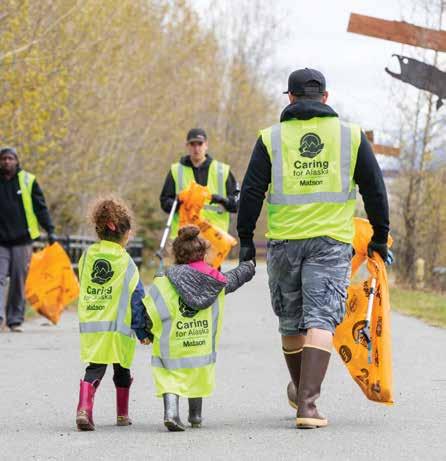 Providing for volunteer time off is not just a perk for employees but a benefit for nonprofit partners, like the Anchorage Chamber of Commerce and its citywide cleanup.
Providing for volunteer time off is not just a perk for employees but a benefit for nonprofit partners, like the Anchorage Chamber of Commerce and its citywide cleanup.
32 | December 2022 Alaska Business www.akbizmag.com
Wayde Carroll | Matson
“At ConocoPhillips Alaska, we have a culture of giving in the communities where we live and work, financially and with our time and talent. This year, our United Way campaign saw historic levels of involvement - 83% of our employees took actions to change a life, reflecting this proud spirit of giving back.

I invite our community to learn more about the work of United Way of Anchorage, join in the effort to remove barriers, and create opportunities so that we can all thrive.”



 Erec S. Isaacson, President ConocoPhillips Alaska
Erec S. Isaacson, President ConocoPhillips Alaska
United Way of Anchorage
When we help others succeed, we all prosper.
BBBS to give presentations. CIRI is also reminding its staff about the corporation’s VTO, or volunteer time off employee benefit. “That’s basically the gold star of a partnership we could have with a business, that a business would give their staff time off to be a Big,” says Richardson. “In return, we can celebrate them and share them with our network and make sure that people know that [the companies have] supported us.”
Positive Brand Alignment
This type of positive brand alignment is a significant benefit to companies, large and small. Be it from social media shares and likes, in-person events, or simply a logo displayed at a fundraiser, companies can gain visibility and
positive regard when aligned with social causes. Even the smallest owner/ operators can devise creative ways to pair philanthropy with profit—an author, for example.

Former Fairbanks police chief Daniel Hoffman, now a security consultant, published a book last year. He knew he wanted to donate 50 percent of the proceeds from the sale of An Alaska Fly Fisher’s Odyssey to Alaska Trout Unlimited. The cover of his first printing of a few hundred copies featured a generic version of the nonprofit’s logo, and once the conservation group saw positive press and reviews for the book, Trout Unlimited teamed with Hoffman to promote
events.
awareness and exposure for the book resulted in a second printing, and sales have far exceeded Hoffman’s initial expectations.
Other nontraditional ways of partnering, especially for smaller businesses, may include donating or subsidizing office space and supplies to nonprofits that can’t afford a dedicated workspace of their own. Inkind donations of professional services are also very welcome, such as legal counsel, photography, and web design. Or the partnership can simply leverage leadership strengths by investing in capacity-building for nonprofits.
As Richardson says, there are “countless possibilities to grow this mission.”
his
The increased
“Companies that put that sort of purpose at the heart of business are more desired and more trusted, and their employees are more motivated and loyal… It has such a positive impact on people that when their employer helps support them to volunteer, I think they will attach those positive feelings to their employer.”
Jill Richardson, CEO, Big Brothers Big Sisters of Alaska
34 | December 2022 Alaska Business www.akbizmag.com
Big Brothers Big Sisters


Be part of Southcentral Foundation’s award-winning team! At Southcentral Foundation, we support every employee’s career journey with academic and wellness leave, personal leave, paid holidays, and competitive pay. Begin your career at Southcentral Foundation. • Behavioral Services • Dental Services • Finance • Administrative • Information Technology • Medical Services • Clinical • Technical and Professional Training Programs • And More! Apply today! SCFJobs@southcentralfoundation.com
Native
Alaska
People Shaping Health Care
Alaska's Healthcare
COVID-19 is old news: that’s the key takeaway from this month’s special section on the healthcare industry, judging by the lack of articles on that topic. The novel coronavirus is still lurking, but the novelty has worn off. According to the Institute for Health Metrics and Evaluation, daily deaths in Alaska have dropped to less than one per day after peaking in January at nearly ten. Estimated infections surged in July and August but have settled at around 2,000 on any given day, about the baseline trend all year.
Thus, with COVID-19 not exactly in the rearview mirror but riding quietly in the back seat, the special section can ask some different questions about healthcare.
What role can animals play? “A Helping Hoof (or Paw)” has the answers.
Where can transgender Alaskans seek medical resources? “Affirming Care” finds the providers.
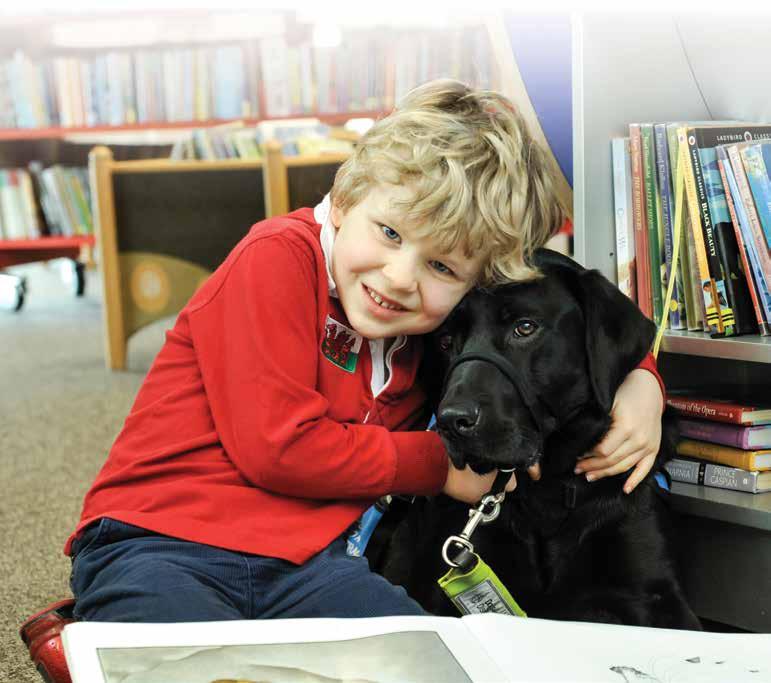
36 | December 2022 Alaska Business www.akbizmag.com HEALTHCARE
Which pain management options do physicians favor? “A Battle of Nerves” reviews the state of the art and the new research being conducted locally.




How are assisted living facilities meeting the needs of Alaska’s aging population? A recent construction boom means that “Seniors Have Choices.”
And who disposes of icky medical waste? Meet them in “Waste Away.”




For further healthcare data, flip to the Alaska Trends section for data about workforce and wages.

Alistair Heap | Alamy
Country
Alaska Native
Pair this knowledge with human, approachable legal services
Schwabe, Williamson & Wyatt P.C. 420 L Street, Suite 400 | Anchorage, AK 99501 | (907)
| schwabe.com www.akbizmag.com Alaska Business December 2022 | 37 HEALTHCARE
Preserving cultures and enhancing communities, represented by Schwabe. Indian
&
Corporations We don’t just settle on knowing your industry. We live it. Spotting trends and navigating turbulent waters can’t happen from behind a desk. The insights come when we put on our hard hats and meet our clients where they are.
and you’ll see what it means to be represented by Schwabe.
339-7125
Speople. Therapy dogs, for example, are used to instill confidence in children learning to read or to provide comfort for patients during cancer treatments. Even horses are getting into the act, not only providing a soothing presence but helping those with physical disabilities to learn balance and gain confidence.
“We have so many success stories here,” says Christy Constantini, executive director of Equine Assisted Therapy Alaska (EATA).
The Anchorage-based nonprofit organization’s goal is to enhance the physical, psychological, and social well-being of Alaskans living with disabilities through therapeutic horsemanship. Originally called The Rainbow Connection, the seasonal program provides services to children and adults with mental, behavioral, cognitive, and physical disabilities.

A Helping Hoof (or Paw)
Therapy animals and human wellness
By Vanessa Orr
38 | December 2022 Alaska Business www.akbizmag.com HEALTHCARE
afefelov | iStock
“Some of the kids who don’t speak come for speech therapy,” Constantini explains, “and once they get on a horse, they start talking or relating to the horse. We’ve had a number of people with social anxiety start to talk to other people once they’re in the arena, and this happens with our volunteers as well.”
Constantini has been with EATA since 2007, first as a rider before joining the board of directors.
“I look at it from a different point of view than those who are ablebodied,” she says. “I have multiple sclerosis, and working and riding horses fills my cup. I have dealt with a lot of things in life, and I find that horses give me support and keep me grounded. They help with my physical and emotional needs.”
Constantini says she observes the same fulfillment in others, both riders and the volunteers who lead them around the ring at the William C. Chamberlin Equestrian Center or on trails in Ruth Arcand Park in the Lower Hillside neighborhood.
“Being able to relate to an animal builds confidence, improves socialization, and builds strength and character,” she adds. “When a person attains their goals, it builds confidence and they feel empowered, and after they leave the center, that carries on in life.”
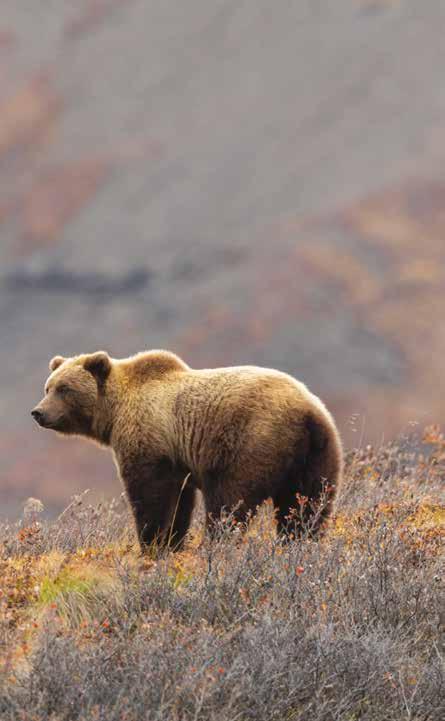
While children may at first be worried, Constantini says that it only takes one try before they begin to feel comfortable.
“Kids are nervous and scared the first week; they’re not used to being around a 1,500-pound animal,” she says. “By the second week, they are ready to go. Kids are amazing because they bond with the horses that they are assigned for their sessions. They draw pictures of them and bring them carrots and come to visit them.”
Constantini does recall one girl who would not get on a horse. “At first she was upset and crying, but eventually didn’t want to get off,” she says. “The transformation is stunning; it’s just
amazing. There are a lot of tears of joy shed here.”
To the Rescue
Dani Adams, human resource assistant for the City of Wasilla, knows the importance of therapy animals firsthand. As a student earning her bachelor’s degree at a Kentucky university, she was able to visit with therapy dogs that the university provided once a month.
“When I was with them, I noticed that overall, my stress level went down,”

Midas the Bernese mountain dog early in training. Dog Works Training Co. Employee Benefits | Property & Casualty Programs | Personal Risk | Retirement Consulting © 2022 USI Insurance Services. All rights reserved. Alaska Isn’t Just Any State. USI Isn’t Just Any Broker. The consultants in USI’s Anchorage & Sitka offices know Alaska like their own back yard because, well, it is. With decades of presence & experience in the state, our Alaskan teams deliver informed perspectives & customized brokerage & consulting solutions to aid Alaska-based businesses in addressing the specific & unique challenges they face. Call Anchorage: 907.272.0114 Sitka: 907.747.8625 or visit usi.com www.akbizmag.com Alaska Business December 2022 | 39 HEALTHCARE
she says. “If I was feeling anxious, the dog would lay its head on me and calm me down. The students really looked forward to the days that the dogs came.”
After taking her job in Wasilla, she hoped to find something similar that could help emergency dispatchers. “This is a high-stress job in a 24-hour facility, and because the dispatchers are in a separate building, they may not feel as much a part of the team as we’d like,” says Adams. “I wanted to provide them with something that could make their job easier.”
To this end, Adams worked with local trainers to increase the number of times that therapy dogs visited with dispatchers. Pet Partners’ handler Terry Yeomans and her dogs Tia and Sawyer and National Crisis Response Canines handler Karen Quist and her dog Roo now visit the Wasilla dispatch center regularly to deliver puppy cuddles.
“Both handlers visit the center approximately once a month and have been incredibly helpful to the city as we work to build our own therapy/ facility dog program for the future,” says Adams. “I originally wanted to have an on-site facility dog but ran into a few technical difficulties; it was a more indepth process than I expected.”
A facility dog is a therapy dog assigned to a particular location, explains Michele Forto, owner of Dog Works Training Co. in Willow. She gives the example of a dog that works in a dentist’s office and doesn’t provide services anywhere else.

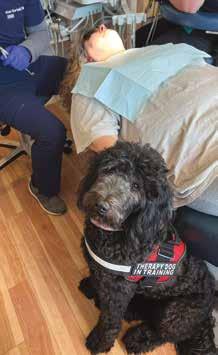
In addition to relieving stress, Adams believes therapy dogs help with recruiting dispatchers when prospective employees realize the perk that the City of Wasilla provides.
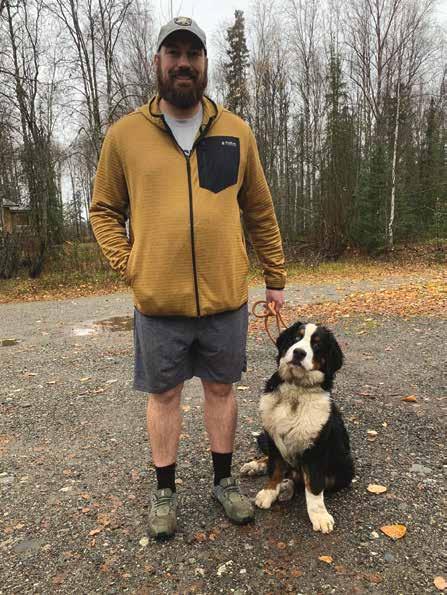
“It’s very hard to find people in emergency services,” she says. “We’re getting staffing levels up, but for a while during COVID, we were having a hard time filling those gaps. I’m in charge of recruitment and doing what we need to do to make people want to work here. The therapy dog program could be a big benefit.”
Support and Service Animals
While pets aid humans many ways, there is a difference between therapy animals, emotional support animals, and service animals.
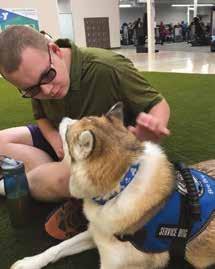 Midas later in training to become a service dog.
Dog Works Training Co.
Cassmus completed the Canine Good Citizenship test, part of foundational obedience training for any therapy or service dog.
Dog Works Training Co.
Visiting the dentist doesn’t have to be stressful when Lucy is around.
Midas later in training to become a service dog.
Dog Works Training Co.
Cassmus completed the Canine Good Citizenship test, part of foundational obedience training for any therapy or service dog.
Dog Works Training Co.
Visiting the dentist doesn’t have to be stressful when Lucy is around.
40 | December 2022 Alaska Business www.akbizmag.com HEALTHCARE
Dog Works Training Co.
An emotional support dog, for starters, is defined by federal housing rules.
“Any and every dog provides individuals with emotional support, but under the Fair Housing Act definition, these are animals that are allowed to live in dwellings with their owners even if the landlords do not allow dogs,” says Forto. “These animals don’t have specialized training; a person just needs to provide a note from their mental health provider that the animal is needed for depression or anxiety, for example. These animals have no right to go anywhere else in public other than where dogs are already allowed, unlike therapy dogs, which can go to certain prescribed locations.”






A service dog, on the other hand, is trained to perform specific tasks, such as guiding those without sight or providing medical support or medical alert services. This specialty training can take up to two years.
“One of my medical alert dogs is trained to bring a medical bag containing an inhaler to a client







who has severe asthma,” says Forto. “I also train mobility dogs for people in wheelchairs or who have ambulatory issues.”


Therapy dogs provide services to individuals in hospitals and adult care centers, as well as after natural disasters and school shootings. They begin their working lives at age 2 after obedience training. According to Forto, training for therapy and service dogs always begins with foundational obedience; dogs can proceed through intermediate obedience and advanced obedience, which involves training in specific environments.
“With service dogs, we start working on the specific commands that an individual client requires during the foundational obedience portion of training and throughout their twoyear training process,” says Forto. “The programs through our Lead Dog service dog program at Dog Works Training Co. are not cookie-cutter; they are very individualized.”
Forto’s specialty is training dogs to work with healthcare providers in medical practices or school settings.

“Being able to relate to an animal builds confidence, improves socialization, and builds strength and character… When a person attains their goals, it builds confidence and they feel empowered, and after they leave the center, that carries on in life.”
Auditing, Review, Compilation Tax Consulting & Preparation Accounting & Payroll Management Consulting Election & Tabulation Services Personal Attention Let Altman Rogers help grow your business with big rm resources and the personal attention only a locally owned rm can provide. altrogco.com | 907-274-2992 Like You. Fiercely Independent 2992 Anchorage | Juneau | Soldotna Call Today! 907-261-7620 or 907-244-4194 nk@alaska.net • Value Assessment • Consultation • Marketing • Results 30+ Years Experience Alaska Mergers & Acquisitions is af liated with Remax Dynamic Properties, Inc. Time to sell your company? www.akbizmag.com Alaska Business December 2022 | 41 HEALTHCARE
Christy Constantini Executive Director Equine Assisted Therapy Alaska
“A therapy team, which includes the dog and its owner/handler, may go to a hospital or a school for visits that typically take two hours a week, for no more than eight hours a month,” she explains.
Through Dogs Assisting with Grace, or D.A.W.G.s, which was started in 2008, Forto has trained therapy dogs to work at a charter school, where children read to the dogs. She also trained therapy dogs to participate in a Meals on Wheels ministry for a local church. She has also trained several teams stationed in medical providers’ offices and in occupational and physical therapy clinics.
Bred for Bonding
Any dog can become a therapy dog, but some are better suited temperamentally than others.

“I look for animals with a high pack drive—which makes them good companions—a medium prey drive, and a very low defense drive,” says Forto. “Personality and temperament also play a part.”
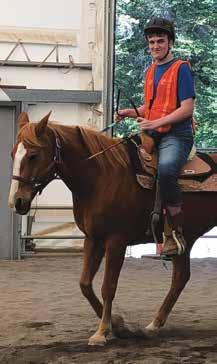

German shepherds, golden retrievers, and Labrador retrievers are most often used as service dogs, though Forto has trained other breeds, including labradoodles and a Bernese mountain dog, to help specific clients.
“While other programs may give a person an already-trained 2-year-old dog and then send them through a one-month program where they learn to interact with the dog, we want to develop a dog’s bond with its owner from the minute we get it, from the age of 8 weeks until it’s 2 years old,” says Forto. “That way, the person is learning to recognize what the dog is telling them and to recognize certain behaviors.”
Forto charges a flat rate for a therapy dog, which includes all basic, intermediate, and advanced training as well as personalized training geared toward healthcare providers. She also provides training advice and other information on her Dogworksradio.com podcast.
“In the end, my goal is to help those who need a service dog, so while my other training programs are more expensive, I offer my service dog program at a lower rate than my competitors,” says Forto. “A service
riding on trails or in the arena, equine therapy is used for physical exercise, social bonding, and even practice with communication.
Assisted Therapy Alaska 42 | December 2022 Alaska Business www.akbizmag.com HEALTHCARE
Whether
Equine
dog gives a person freedom, security, and the confidence that they’ve lost because of their disability; it helps the person through the transition and helps return them, as much as possible, to a sense of normal.”
Saddle Up

Horses seem to work the same magic, with the addition of physical exercise. EATA currently works with four different pediatric clinics in Anchorage by offering “hippotherapy.”
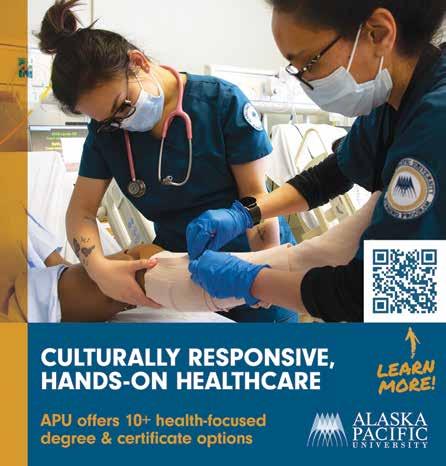
“When you sit on a horse, it helps to improve balance and instills a sense of confidence,” says Constantini. “Their gait mimics the human gait and enables riders to stretch their hips and move their legs and helps improve core strength.”
Children follow a plan of care that includes one-hour rides once a week for 8 or 10 weeks, during which they have goals to attain in areas including speech, occupational, or physical therapy. In addition to four paid staff, volunteers help lead the horses and care for the animals.
“Most years we have a waiting list,” says Constantini of the program that serves people of all ages. “Our biggest hurdle is to find and maintain enough volunteers to run the program; we could serve three times the amount of people, but there just aren’t enough horses or time.”

The EATA program runs from June to August; during the rest of the year, Program Director Janie Call houses the horses at her farm in Bend, Oregon. During that time, she desensitizes the animals to toys, rubber balls, and other items therapists use during their sessions.

According to Constantini, the seven horses in the EATA herd can tell the difference between someone with a disability and someone without. “They are so intuitive; they act differently with someone with a disability—they are so gentle and kind,” she says.
For such large animals, horses bring a serene energy to therapy sessions. “They can sense if you’re happy or sad, and they project their energy to help you feel better,” Constantini says. “I can’t explain it other than horses have an intuitive nature to humans, and they know what you need when you’re here.”
www.akbizmag.com Alaska Business December 2022 | 43 HEALTHCARE
Seniors Have Choices
New options for assisted living in Anchorage
By Dimitra Lavrakas
Alaska’s population over the age of 65 topped 100,000 for the first time in 2021. This age group is projected to grow faster than any other cohort for the next decade or so. The Alaska Department of Labor and Workforce Development’s September issue of Alaska Economic Trends anticipates a rising tide of seniors until a peak in 2035, when the oldest Baby Boomers reach 90.
This demographic pulse needs somewhere to live. When Boomers were younger, options for their parents or grandparents were often limited to a full-service nursing home or toughing it out alone or with family during their golden years. These days, though, Alaskans have more options, ranging from independent living to assisted living and even specialized dementia care.
Alaska Native corporations, housing authorities, private companies, and the Alaska Housing Finance Corporation are busy building innovative senior housing and care complexes.

Fulfilling Development
The first phase of the East View Assisted Living project opened in midOctober as a home-style approach to senior living.
Five individual homes, all with a unique name and color scheme and accommodating five residents each, are opening in phases. The Brooks house is the first and is being followed by Augustine, Chugach, Denali, and Edgecumbe in early 2023.
44 | December 2022 Alaska Business www.akbizmag.com HEALTHCARE
With lots of windows, stunning mountain views from its spot at the top of a hill, bright rooms bathed in natural light, high ceilings, and cheery spaces, each home has been designed to create a comfortable living experience for residents.

Residents are charged for room and board separately from supportive services provided by 24-hour staff. “The costs vary on type of room and individual needs of residents,” says Erica Miller, manager of East View, an Anchorage-based company that built the homes with private funding.
“At East View, we approach senior care understanding that each day entrusted to us is ever increasing in value during this phase of life,” states James Drayton, East View director. “We recognize that each day should be lived with purpose, incorporating
elements that bring joy and fulfillment. This is done by providing our customers with a space designed by Alaskans, for Alaskans based on their unique values. Through thoughtful design, our program uses clients’ input to shape environment, cuisine, activities, and, ultimately, relationships that make a house a home.”
Design for Dementia
Tucked in the woods off Tudor Road in Anchorage’s hospital district sits the Providence Horizon House complex that offers an array of supportive residences for seniors in all stages of aging.
The Birch and Spruce cottages are designed for residents with Alzheimer’s disease or other memory conditions. The first of their kind in Anchorage, the cottages are attached by a walkway


to the Horizon House apartments so that a resident never feels lost, even if memory loss renders them unable to navigate outside their home.
Birch and Spruce are the two large cottages containing eleven bedrooms each, and they include assistance with daily living activities and lifeenhancing activities designed around dementia care.
“All apartment units are studio-style apartments with a private bathroom,” says Mikal Canfield, senior manager for external communications for Providence Health and Services Alaska.
Canfield says Providence is not currently planning to expand its assisted living offerings in Anchorage, but the healthcare provider is building a new facility for elders with chronic health issues who experience homelessness. That project, called Alaska House,
 The Great Room at Maple Springs in Anchorage echoes the grand lodges of Alaska.
Maple Springs’ outdoor courtyard is an ideal space for residents to enjoy nature and engage in activities and conversation.
The Great Room at Maple Springs in Anchorage echoes the grand lodges of Alaska.
Maple Springs’ outdoor courtyard is an ideal space for residents to enjoy nature and engage in activities and conversation.
East View Assisted Living
Maple Springs Anchorage
The Alaska Housing Finance Corporation and Cook Inlet Housing Authority joined hands to build Ch'bala Corners, a multi-generational housing complex in Anchorage's Spenard neighborhood.
www.akbizmag.com Alaska Business December 2022 | 45 HEALTHCARE
Alaska Housing Finance Corporation
is scheduled to open next August in Midtown, across Eagle Street from the Providence network’s St. Elias Specialty Hospital. The initial stage is a fourstory residential building with fifty-one studio units.
Alaska House will have additional spaces for case management consultation rooms, exam rooms, and a computer lab. A common laundry area and gathering spaces are also included.
Providence Supportive Housing partnered with Southcentral Foundation, Cook Inlet Tribal Council, the Anchorage Coalition to End Homelessness, and Catholic Social Services to bring this project to life.
All the Trimmings
Cook Inlet Region Incorporated (CIRI) opened Maple Springs Senior Living in February with a mission “to encourage lifestyle options by providing personalized care and firstclass service.”

The facility centers on a great room reminiscent of grand Alaska lodges, complete with a mammoth stone fireplace and, of course, comfy stuffed chairs. The dining room is spacious and filled with light.
Built on CIRI-owned land near Klatt Road in South Anchorage, the 107,500-square-foot facility features seventy-nine assisted living units and twenty-eight memory care units. In 2024, CIRI plans to open a skilled nursing facility, and there is more land for future expansion.
Activities and outings keep residents engaged and active, and Maple
Springs offers many opportunities: an art room, movie theater, ice cream and coffee bistro, puzzle rooms, computer rooms, outdoor walking paths, and functional gardens.
“We offer studios, one-bedroom, and two-bedroom units with kitchenettes in our assisted living and have all studios in our memory care,” says Heather Jacox, community relations and marketing director for Maple Springs. “All of our rooms are private rooms with private bathrooms.”
Bathrooms come with a shower or a Jacuzzi tub, according to the preferences of the tenant.
Sprucing Up Spenard
Cook Inlet Housing Authority’s (CIHA) Ch’bala Corners development is currently moving tenants to its Phase I facilities, which include three buildings: senior housing with nineteen apartments, an eight-plex garden-style building for families and individuals, and a twenty-one unit multifamily building, for a total of forty-eight units of affordable housing.
As of mid-October, thirty-five of those units had been leased, says Sezy Gerow-Hanson, director of public and resident relations at CIHA. Phase II is planned with another thirty-three apartments, she adds.
Ch’bala Corners is one of twentythree CIHA projects funded through Alaska Housing Finance Corporation’s Greater Opportunities for Affordable Living (GOAL) program, which provides grants, federal tax credits, and zerointerest federal loans to build rental
housing for low- to moderate-income families and seniors.
Ch’bala means “spruce tree” in the Dena’ina Athabascan language, and Ch’bala Corners is just the latest affordable housing project to sprout in the Spenard neighborhood. CIHA also has been busy building affordable housing in Eagle River, Ninilchik, and Chickaloon—but Spenard is the authority’s backyard. Ch’bala Corners is kitty-corner from CIHA headquarters at 36th Avenue and Spenard Road, and CIHA also bought the former Church of Love next door to its offices and renovated the building into The Nave, a community and cultural hub hosting a range of activities, from meetings to art exhibits.
Bringing new life to an old Anchorage neighborhood with somewhat of a rough-and-tumble past, CIHA's housing developments are reshaping Spenard with affordable and attractive housing near shopping, transportation, dining, and entertainment. The housing authority has taken a holistic approach by looking at the entire area and not just an isolated spot where its projects are built.
The foundations being laid now to care for aging Baby Boomers will continue to be useful into the middle of the century. The state’s population projection forecasts a decade-long lull in the growth of the over-65 age group, but after 2045, the oldest Millennials will start turning 65. If retirement is still a thing by that time, today’s thirtysomethings will have plenty of choices where to live.
Providence's Horizon House offers a spectrum of senior living accommodations for seniors according to their needs.
Providence Alaska
46 | December 2022 Alaska Business www.akbizmag.com HEALTHCARE
Program


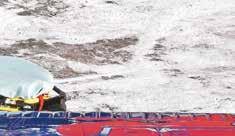




24-Hour Medevac Dispatch: 1.800.478.5433
Membership
is
$49
that
Terms
LifeMed Alaska Membership
The LifeMed Alaska
Program
available for
per year
covers all LifeMed Alaska transport fees not covered by the patients’ primary health insurance. There is no waiting period to enroll and the program is available to all Alaskan residents and visitors.
and conditions apply.
memberships.
FORYOURWHOLE HOUSEHOLD MEMBERSHIP PROGRAM$49 PER YEAR
provides safe, full-scope air medical transport services throughout
to critically ill or injured infants, children and adults utilizing jets, turbo-props and
3838 W. 50th Ave. | Anchorage, AK 99502 | O ce: 907-563-6633 | Fax: 907-563-6636 | www.LifeMedAlaska.com Always here f you ALASKA’S MEDEVAC COMPANY
Group Memberships LifeMed Alaska also o ers group
Visit www.lifemedalaska.com/groupmemberships to start your application. For questions, call 855.907.5433 or 907.249.8358 or email membership@lifemedalaska.com.
LifeMed Alaska
Alaska
helicopters.
Affirming Care
Transgender healthcare resources in Alaska
By Scott Rhode
Being transgender is more than a medical condition; it is an aspect of human lives. That said, transgender people have, by their nature, special healthcare needs.
Since 2014, when TIME magazine signaled a “Transgender Tipping Point,” the number of Americans who say they know a transgender person has grown from 9 percent to 44 percent (plus 20 percent who know someone who is gender nonbinary), according to a Pew Research Center survey. The population who themselves identify as a gender other than one assigned at birth remains about 0.5 percent, yet that fraction is more visible.
“People did not talk about gender and gender diversity” a decade ago, says Lynn Murphy, operations director for Identity Health Clinic in Anchorage, “and now the young kids have role models, they have people they can look up to, so they feel safer by coming out as gender diverse.”

48 | December 2022 Alaska Business www.akbizmag.com HEALTHCARE
Alaska Business
Identity started in 1977 to advocate for the LGBTQ community in Anchorage. The nonprofit acquired a healthcare branch in 2020 by absorbing Full Spectrum Health, established in 2017 by Tracey Wiese, a doctor of nursing practice. “At the time, I was the only clinic in Alaska that was openly marketing to the queer community,” Wiese recalls. “I had friends who were in my kitchen crying because they couldn’t find providers to prescribe hormones.”







Full Spectrum Health was renting space in the same Midtown building as Identity, but after a couple of years Wiese realized she couldn’t stand alone. “I’m not a business person, so I kind of opened out of passion, which is not always a good foundation to start a for-profit business,” she says. With at least half of her patients covered by Medicaid, the clinic’s books looked more like a nonprofit. Wiese, who was already on the board of Identity, offered to let the group take over.
Gender-affirming care has likewise been added to the services offered at Chena Health in Fairbanks, which began as an OB/GYN clinic in 2006. “It’s certainly become more of a part of family medicine practice,” says founder Dr. Ellie Hogenson. “I think as the number transgender individuals grows, people are going to have to know how to appropriately treat them.”



Living as Trans






Hogenson is not just a provider of healthcare for transgender patients; she’s a seeker on behalf of her daughter. “It was kind of a strange coincidence because I was doing transgender medicine for years, and then she came out about three years ago,” Hogenson says. “She was definitely a little girl, and I didn’t recognize it, I think.”
A social work intern at Identity is definitely a middle-aged guy: full beard, hair thinning on top, a little soft around the middle. However, Vincent Feuilles (pronounced foyay) is shorter than the average male, and his hands are smoother than his side gig as a leathercrafter might suggest. That’s because Feuilles had to become himself.
“Trans guys, we’ve got it a little easier because we just look young,” he explains.

Phone: (907) 248-0179 | www.cookinlettug.com POWER BUILT FOR ALASKA The Alaskan environment poses tough challenges. Our equipment and operators stand ready to support your transport needs. www.akbizmag.com Alaska Business December 2022 | 49 HEALTHCARE
Images by Dan Butts.
Feuilles came out in 1991 while living in Seattle but couldn’t find transgender peers or other support. “There were no doctors who would talk to you if you were trans, anything like that. If there was, it was kept extremely quiet,” he says.
He moved to Alaska in 2008 and was able to find a gynecologist in Fairbanks for hormone therapy. “He was like, ‘Okay, I don’t know a lot about it, but let me do the research,” Feuilles recalls. He now uses a daily Androderm patch, the same testosterone prescribed for cis men with low-functioning gonads.
After moving to the MatanuskaSusitna Borough, Feuilles needed a new
doctor to maintain his medications. “I had to educate him on, ‘These are where the levels should be. Look, here’s this and this and this.’ Which is what a lot of trans folks go through,” he says.
Feuilles notes that not every transgender person has body dysphoria that requires medical treatment. What every transgender person needs, as surely as anyone else, is ordinary medical care, and that service is not always easy to find.
Friendly Providers
“There’s some pretty horrible stories out there for trans individuals trying
to seek medical care, getting rejected, turned away,” says Hogenson, “not just for trans care but patients that are there for an annual exam.”
Identity’s website lists Hogenson as a trans-friendly provider, and she says that’s because she serves patients without judgment while having the knowledge to care for them.
Feuilles says, “A lot of folks will find a doctor who’s really good but maybe just doesn’t have the knowledge of trans healthcare, so they spend a lot of time educating, which is really difficult because you’re supposed to be the patient.”
One resource to connect patients with gender-affirming providers is QueerDoc, a website created by Crystal Beal, a Seattle-based doctor on staff at Identity Health Clinic. In addition to facilitating telehealth services, Beal's website aims to increase the availability of in-person care by training healthcare professionals and other organizations.
It’s the kind of training Hogenson says most doctors never get. “In residency it wasn’t anything that was even discussed,” she says. “This is something that I’ve sought out educational opportunities after training.” Hogenson points to guidelines published by the Endocrine Society and the World Professional Association for Transgender Health.
Trans-friendly providers ask questions, assess patients, and order labs in a slightly different way, Wiese explains. “These are competencies that come from several professional organizations,” she says. “We offer that in a way that’s gonna look different if you go down the street.”
Those competencies extend to all staff interactions. “Somebody who understands them, somebody who calls them by their right pronoun, is able to use their name, not their deadname,” Murphy says.
A transgender patient might find a friendly practitioner anywhere for routine medical needs. For transgenderspecific services, though, options in Alaska are slim to none.


First Steps
Recognizing a mismatch between assigned gender and internally perceived gender sends a person on
In 2020, Tracey Wiese (left) handed over her Full Spectrum Health clinic to Identity Inc., largely thanks to Joey AgloingaKeeney, then the nonprofit’s co-chair, arranging the purchase.
Identity, Inc.
Tracey Wiese (second from right) leads a discussion during a 2021 visit to Identity Health Clinic from Anna Dietderich (in purple), a legislative assistant to US Senator Lisa Murkowski.
Identity, Inc.
50 | December 2022 Alaska Business www.akbizmag.com HEALTHCARE
a transformational journey. “Some people come in wondering if they’re trans, wondering if what they’re feeling is gender dysphoria, and for that individual—just like any human coming in with some kind of identity or existential question—it would be therapy with a competent, trained provider,” Wiese says.
Counseling is a major part of Identity Health Clinic’s offerings. Wiese finds herself treating not just gender dysphoria but also the syndrome that comes with living as a marginalized minority. “It looks like you have PTSD, even if you don’t have any other trauma, because your body is so used to coping with daily stress and fear,” Wiese says.
Feuilles observes that social marginalization leads to economic disadvantage among the trans community, which is why most clients receive assistance from Medicare or Medicaid. Thus, Feuilles chose the field of social work, which is more accessible to Medicaid billing codes than psychological counseling.

During his internship while finishing a Master of Social Work degree,

Feuilles is also a contractor at Identity Health Clinic through his peer-topeer consulting service, Authentic Beginnings. He mainly assists clients with changing their names and gender markers. Any lawyer’s office can do it, but Feuilles (although not a lawyer) is a specialist. “Usually, attorneys will charge quite a bit more,” he says. “As far as the gender marker change, I am the only one in Alaska who has paperwork for submitting a gender marker change into the court system.”
Legal recognition is the third of four steps that Feuilles counts along a transgender journey, after the internal transition and social expression. The last step is medical intervention.


Medication and Surgery
Since June 2021, state Medicaid funds have partially covered hormone therapy and gender-affirming surgery. That month, the Alaska Department of Health and Social Services settled a lawsuit challenging a decade-old policy against such coverage.

Patients without Medicaid or other insurance can still find help at

R e a c h
A l a s k a ' s
H e a l t h c a r e
L e a d e r s
Anchorage Neighborhood Health Center (ANHC). “We have a sliding scale for uninsured patients at ANHC to make sure that anyone who needs care (gender affirming or otherwise) can get it,” says the center’s chief medical officer, Dr. Rachel Samuelson.


One of ANHC’s former physicians is out of state for the moment, upgrading her skills. Massachusetts General Hospital has a special program in transgender health, so Dr. Rachael Carricaburu is finishing her internal medicine residency in Boston. “I know the gaps in care that exist for people in Alaska, and I continue to seek training to fill those gaps. Transgender medicine is just one of those things,” Carricaburu says.
Surgery, in particular, is in short supply. The last doctor in Alaska doing “top surgery” for trans men died a year ago, according to Feuilles.
“There are plastic surgeons in Anchorage who will do breast augmentation, but only for cisgender women,” Feuilles says, “and the surgeries are different, too. For a trans man, people want to say it’s just a mastectomy, but it’s not.”
For 70 years, the Alaska Hospital & Healthcare Association (AHHA) has served as a non-profit trade association representing Alaska's hospitals, nursing homes, and other healthcare partners across the continuum of care.
We welcome businesses and community partners to join us as associate members and event sponsors. Build connections and visibility with top leadership in the Alaska healthcare landscapecontact jmylet@alaskahha.org today! www.akbizmag.com Alaska Business December 2022 | 51 HEALTHCARE
Although billed the same as a mastectomy, top surgery requires reconstruction to create a male chest contour. “While some of the techniques might be similar, the procedures [are different] to do the scar tissue in a certain way, to perhaps graft nipples,” Wiese explains. “There’s a joke out there that some surgeons do designer nipples.”
The only other surgery available in Alaska is orchiectomy, or removal of the testicles. All other “bottom surgery,” as well as facial and vocal surgery, must be sought out of state. Medicaid pays for travel, but Wiese says convincing surgeons to accept Medicaid is a hard sell when a $10,000 procedure might only get $1,600, a rate she calls “abysmal.”
Meeting the Need
As the stigma around gender diversity fades, Hogenson expects to see more demand for gender-affirming services, and providers will rise to meet it. “There are more and more providers in Fairbanks that are feeling comfortable providing these services,” Hogenson says.
Identity Health Clinic has been seeing more than twenty requests for new patients each week. “Patients keep coming, and we are still working to meet the need,” Wiese says.

The clinic is about to double its size, thanks to $300,000 of federal stimulus money through the Municipality of Anchorage, matched by donations. The 1,000 square-foot expansion adds two exam rooms, two more offices, a training room, a waiting room, and an accessible ramp for the front door and a wheelchair lift to the second floor.
The expansion is meant to alleviate constraints that disrupt patient care. “Any medical clinic is limited in profit by space,” Wiese says. “You can only have so many folks going at one time, and you need more providers to support more staff.”
Those providers don’t necessarily have to be within Identity’s walls. “We want to put ourselves out of business. If we didn’t have to have a health clinic— and our community was well—that’d be great because that would be a signal to us that we had done our job,” Wiese says. “But we’re not there.”
 Renderings show the new lobby (above) and wheelchair lift in the stairwell (below) at Identity Health Clinic in Midtown Anchorage, part of an ongoing expansion project.
Renderings show the new lobby (above) and wheelchair lift in the stairwell (below) at Identity Health Clinic in Midtown Anchorage, part of an ongoing expansion project.
52 | December 2022 Alaska Business www.akbizmag.com HEALTHCARE
Determine Design
You bring out the best in us.
Alaska’s most award-winning hospital.
Providence Alaska Medical Center has once again been recognized as the top health care provider in Alaska. U.S. News & World Report, the global authority in hospital rankings, has named Providence Alaska Medical Center as a High Performing hospital in seven categories including heart attack and stroke.







Thanks to the great work of all our caregivers, providers and community partners, enabling us to serve our community with award-winning care.
Providence Alaska Medical Center, a nationally recognized trauma center and Alaska’s only Magnet hospital, is part of Providence St. Joseph Health, a not-for-profit network of hospitals, care centers, health plans, physicians, clinics, home health services, affiliated services and educational facilities. For more information about PAMC, visit alaska.providence.org.

Learn more at Providence.org/PAMCawards
A Battle of Nerves
Alaska clinics research new pain management methods
By Rachael Kvapil
Pain management requires patience, as pain is inherently subjective, its sources often
superimposing and shifting. So says Dr. Luke Liu, founder and CEO of the Neuroversion clinic in Anchorage. Battling pain is his mission, yet he knows the enemy cannot be cured or conquered, only tamed. Calling the field “management” recognizes the limitations of medicine in the face of life’s oldest sensation.

Physicians distinguish between acute and chronic pain. According to the US Centers for Disease Control, acute pain is often defined as pain lasting four weeks or less, experienced by patients of all ages due to various conditions, including post-surgical recovery. In comparison, chronic pain lasts three months or more and can be caused by a disease or condition, injury, medical treatment, inflammation, or even an unknown reason.
According to Liu, pain management starts with identifying sources. Chronic pain, he says, is a summation of physical, psychological, and social factors that can potentially produce associated complications such as depression, anxiety, chronic fatigue, decreased physical function or disability, poor quality sleep, excessive use of medication or alcohol, general dependent behaviors, adverse reactions from extended medication usage, and social isolation. Liu says his team's highest priority is identifying any specific treatable pain generators and providing palliative therapies.
"We aim to break the vicious cycle of chronic pain and improve their physical and psychosocial well-being," says Liu. "We focus on improving the patient's function and quality of life instead of just masking the pain symptoms."
Dr. Claire Stoltz, medical director at Tanana Valley Clinic (part of Foundation Health Partners), adds that the functional goals of pain management are often individual to the patient. She says some patients want to attend family events, others want to live independently for as long as possible, while other patients want to maintain active lifestyles.
"This is going to look different for each patient," says Stoltz. "Very rarely does pain management mean a life completely free of pain, but we continue to work towards limiting the impact that pain has on the patient."
Naeblys | iStoick
54 | December 2022 Alaska Business www.akbizmag.com HEALTHCARE
Holistic Approach
As a family physician, Stoltz sees people for both acute and chronic pain. Chronic forms include orthopedic causes, central sensitization syndrome, fibromyalgia, chronic migraines, and neuropathic pain. At Neuroversion, Liu says staff treat conditions ranging from sports- or work-related injuries to cancer pain, musculoskeletal pain, and visceral organ pain. The most common pains are headaches, neck pain, and low back pain. More rarely, the clinic encounters complex regional pain syndrome or myalgic encephalomyelitis/chronic fatigue syndrome (ME/CFS). Frequently, they treat conditions not typically classified as pain issues, such as post-traumatic stress disorder and long-haul COVID.
Once physical examination and imaging identify specific pain generators, Liu says his staff uses imaging-guided injections or minimally invasive surgery to target the anatomic sources. Procedures include musculoskeletal injections, trigger point injections, joint injections, Botox injections, intravenous and infusion therapies,
peripheral nerve blocks, sympathetic nerve blocks, radiofrequency neuromodulation, radiofrequency ablation, peripheral nerve stimulation, dorsal root ganglion stimulation, spinal cord stimulation, and vertebral augmentations. Likewise, his team can prescribe medications, such as gabapentin, which makes the nerves a little less sensitive to irritation.
"These interventions are designed to normalize the human body’s overwrought nervous system so that the body can instead focus on healing," says Liu.
Stoltz says Foundation Health Partners uses a multi-disciplinary approach to chronic pain that addresses root causes along with lifestyle modification to help with the self-management of pain. This includes physical therapy, osteopathic manipulation, behavioral health support, injections, sleep medicine referrals, or orthopedic referrals to help gradually regain function. When necessary, her team also uses medications.
"It's critical to acknowledge the mental health toll as a result of chronic
pain, so we rely on a holistic approach to management,” says Stoltz.
Stoltz adds that the pain management method must work for the patient while minimizing the risk of harm.
The Trouble with Pills
While medication is the simplest over-the-counter remedy for pain,
Attention HR Professionals And Job Seekers
community where professionals can tap into the local job market and businesses can post their career opportunities.
By Charles Bell Vice President of Sales

Alaska Business Publishing Co. believes in supporting the business community in Alaska and encouraging economic development. A vital component of that growth relies on having a vibrant and skilled labor force.
We are excited to introduce you to the Alaska Business Career Center, an online
The Career Center is a robust resource that provides ample opportunity for growth. For job seekers, the Career Center provides a chance to receive a free resume review, local market career insights, and the opportunity to post a resume for locally registered human resource professionals to review.
The Career Center provides an excellent platform for businesses to reach local talent, manage candidates, and keep a resume bank. You can also expand your reach and target a vast network of candidates by posting to our Ultimate Recruitment Package, which goes to a network of +1,000 websites nationwide.
Whether you are a job seeker or a business looking to hire the most qualified candidates, I invite you to check out the Alaska Business Career Center at akbizmag.careerwebsite.com and see for yourself. The service is free to job seekers, and businesses can post their jobs with packages starting at only $199 for a 30-day campaign.
Alaska Business Career Center
START TODAY: akbizmag.careerwebsite.com
"It's critical to acknowledge the mental health toll as a result of chronic pain, so we rely on a holistic approach to management.”
Dr. Claire Stoltz, Medical Director Tanana Valley Clinic
–SPONSORED CONTENT–EMPLOYERS Post Jobs, Reach Qualified Prospects JOB SEEKERS Search Jobs Post Your Resume
www.akbizmag.com Alaska Business December 2022 | 55 HEALTHCARE
physicians have tried to decrease reliance on pharmaceutical options, given the risks. For instance, prescription opioids have attracted public attention because of their potentially addictive nature. Opioids are a wide range of substances, including the illegal drug heroin, legal synthetic opioids such as fentanyl, and prescription pain relievers such as oxycodone (sold as OxyContin), hydrocodone (Vicodin), codeine, morphine, and many others. Stoltz says opioids carry risks of addiction, respiratory depression, and death. She says patients at risk of respiratory depression should also have a prescription for naloxone, which can quickly reverse the effects of accidental opioid overdose.
"Opioid use and misuse remain a major driver of adverse health outcomes in Alaska," says Stoltz. "As a medical community, we continue to have conversations with patients, work to decrease the risk of adverse events, and refer to support services as needed. Please don’t hesitate to contact your provider if you have concerns."
In general, Stoltz says opioids are not considered a first-line response except
in very rare circumstances. Instead, Foundation Health Partners prefers other tools.
Liu agrees that pain management is more sophisticated than prescribing painkillers and injecting steroids. He feels the role of pain medication is declining because better diagnostic and therapeutic tools are available. In addition to the multitude of non-opioid analgesic medications, he says there are many supplements that patients can discuss with a physician, such as turmeric and magnesium.
"One of the primary goals of an interventional pain management specialist is to reduce medication use, opioid and otherwise, in all patients," says Liu. "Of course, this is generally more feasible in patients with acute or chronic benign pain, as opposed to terminal or cancer pain. However, even in terminal cancer pain, there are often interventional and other strategies that can reduce medication use and, more importantly, the side effects accompanying medications."
Liu says people who have used opioids consistently for a long time may require increasing doses and
might start seeking illicit drugs if they are cut off suddenly. He says many Neuroversion patients who come after years of using high doses of opioids weren’t offered effective non-opioid and non-pharmacological alternatives elsewhere. At that point, his team introduces viable options to wean these patients from opioid dependence.
Patients diagnosed with opioid use disorder work with mental health providers and substance counseling services. Besides providing effective pain management, Liu says they must enforce responsible prescription of controlled medications to keep their patients safe. He says Neuroversion is doing its part to reverse the tide of opioid use and misuse by actively monitoring opioid prescriptions through the Prescription Drug Monitoring Program and transitioning patients to better forms of care.
"Given the horrifying consequences of 'sky’s the limit' opioid prescribing over the past two decades, we now know that long-term high-dose opioid prescription has significant limitations and dangers," says Liu. "Fortunately, the last two decades
 Innovations in pain management over the last two decades mean that opioid medication is no longer the first-line choice.
Innovations in pain management over the last two decades mean that opioid medication is no longer the first-line choice.
56 | December 2022 Alaska Business www.akbizmag.com HEALTHCARE
ureradiancephoto | iStock
have also seen great scientific and technological advancements. We now have an increasing number of tools as an alternative to opioids. These are becoming safer, more comfortable, and more effective."
Patients First

The road to pain management starts with a primary care provider, says Stoltz. Pain management specialists can augment care, but they often need an initial workup, typically through general practice or orthopedics. Liu adds that verifying a provider’s credentials is easily done online and vital to avoid charlatans using marketing ploys to exploit patients' desperation. Liu says there is a moral commitment to be insurance blind and not cherry-pick patients because of potentially better reimbursement or turn down patients based on their coverage.
"We work with patients and insurance companies," says Liu. "We advocate for our patients as much as humanly possible. In many cases, we go out of our way to take care of our patients first and the bottom line second.

Many medical conditions we deal with daily in our clinic are not elective like plastic surgery. Patient care always comes first."

Stoltz says trusting relationships are important, especially when facing the challenges of long-term pain management. Sometimes the existing pain management approach is no longer working, and patients become fearful when a provider suggests a change in protocol. She says fear of change and fear of worsening pain make developing a new approach complicated.


Liu agrees: "Ultimately, trust is paramount. Patients need to trust their provider, and the provider needs to be able to trust the patient to do their part. Respect and trust are earned, and this takes time in a relationship."
Liu adds that each treatment plan must be individualized and adjusted during treatment. Pain management is considered a fluid specialty, unlike cardiology, which has specific protocols based on the most up-todate large randomized control studies. Liu says the nature of pain makes

"Different specialists have their unique perspectives and skill sets… Patients will benefit from a collaborative and synergistic medical ecosystem. At the end of the day, we are all here for our patients, helping to make our community healthier and better."
• Ready to care for Alaska’s next generation • Meet our newest providers, Pediatrician Dr. Michelle Laufer and Pediatric Nurse Practitioner Desiree Cook • Same day appointments available - in person or telemed. • Complimentary no charge pre-natal meeting so expectant parents can meet our doctors and staff to be sure we’re a good fit for the entire family. • On-site lab and radiology diagnostics, same day results. 2211 E. Northern Lights Blvd. I 907.279. 8486 I mpfcak.com Alaskan owned business for over 50 years Come in and meet our Pediatric and Family Medicine Providers!
Dr. Luke Liu, CEO, Neuroversion
www.akbizmag.com Alaska Business December 2022 | 57 HEALTHCARE
Desiree Pediatrics Dr. Laufer Pediatrics
extensive randomized controlled studies challenging to perform and far more complex than treating medical conditions such as appendicitis, fractures, and heart failure. Because of this, it is hard to standardize pain management treatment.
Privademic Practice
Neuroversion is a “privademic” clinic—a private practice with an academic side. Besides taking care of patients and advancing the field of neuroscience, Liu and his team work with, educate, and cultivate students pursuing careers in medicine. Since Neuroversion opened in 2016, seven staff members have transitioned to medical school, and many more have gone on to careers in nursing and physician assistant programs.
"It is my vision that Neuroversion will continue to offer students secondto-none clinical exposure to chronic musculoskeletal and neurological ailments," says Liu, "providing them the opportunity to develop and confirm their professional interest in medicine and pain management."
Deborah Duricka, a clinical research scientist at Neuroversion, collaborates with top researchers around the world. She says Neuroversion currently has two kinds of ongoing clinical trials. They are part of several multi-site Phase 5 clinical trials for neuromodulation devices. Duricka says this clinical trial will determine whether this device only works with a very select patient population in controlled conditions (efficacy) or if it works in the real world with all of its complications (effectiveness). They are also in the process of setting up a single-site Neuroversion-based clinical trial to test the effectiveness of stellate ganglion block for ME/CFS, funded by a grant from Solve M.E., a nonprofit dedicated to researching the condition. A similar trial for long-haul COVID is also planned in collaboration with international research groups. Duricka says they may consider applying for federal grants if it proves beneficial.
Research into new pain management methods helps patients who fall into difficult diagnostic and treatment categories, says Duricka. She feels clinical research is pivotal to exploring innovative treatments
and validating their safety and efficacy. She adds that independent clinical research (grant-funded rather than industry-sponsored) is critical because it's not profit-driven. Clinical trials are labor intensive and expensive, so if a new therapy has the potential to make a profit, then there is a financial incentive for manufacturers to sponsor clinical trials. In the absence of industry interest, Duricka says research departments depend on grant funding, which is fiercely competitive.
"There are plenty of ‘off-label’ treatments out there being used routinely by physicians that aren’t covered by insurance, partly because sufficiently rigorous clinical trial data has not been generated," says Duricka. "Only through objective clinical research can we obtain new therapies accepted by the medical establishment and insurance payers."
With remote communications becoming more convenient, conducting clinical trials in Alaska isn’t as difficult as expected, Duricka says. Traveling to the clinic from outside Anchorage is still a challenge, she admits, but that’s true for clinical care as well. Fortunately, many parts of a clinical trial don’t require the patient to be physically present.
Liu thinks Alaska is uniquely positioned to contribute to the everevolving fields of neuroscience and interventional pain management. At Neuroversion, Dr. Ben Ekstrom and Dr. Wendy Gaultney are spearheading a multidisciplinary pediatric pain management program, which Liu says hasn't been accomplished outside academic settings anywhere in the world.
"Different specialists have their unique perspectives and skill sets," says Liu. “Patients will benefit from a collaborative and synergistic medical ecosystem. At the end of the day, we are all here for our patients, helping to make our community healthier and better."
Great pain management providers, Liu believes, are those willing to think outside the box since many pain and neurological conditions don't have cookie-cutter treatment recipes. He recalls advice from an attending physician during his residency: “Be a cowboy—but not an outlaw.”
"There are plenty of ‘off-label’ treatments out there being used routinely by physicians that aren’t covered by insurance, partly because sufficiently rigorous clinical trial data has not been generated… Only through objective clinical research can we obtain new therapies accepted by the medical establishment and insurance payers."
58 | December 2022 Alaska Business www.akbizmag.com HEALTHCARE
Deborah Duricka Clinical Research Scientist Neuroversion
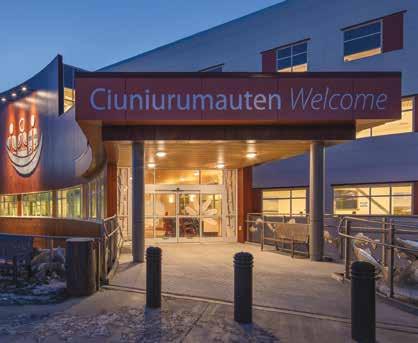

HEALTHCARE IS DIFFERENT We are Alaska’s Community Builders . We’ve designed regional healthcare facilities like Yukon-Kuskokwim Delta Regional Hospital in Bethel, urban hospitals such as the Fairbanks Memorial Hospital surgery addition, and local clinics from Savoonga to Kodiak. The unique character of each community inspires our best work. www.bettisworthnorth.com FAIRBANKS 212 Front Street, Suite 200 T 907.456.5780 ANCHORAGE 2600 Denali Street, Suite 710 T 907.561.5780
ALASKA
Waste Away
The unending chore of medical trash
disposal
By Katie Pesznecker
At a strip mall in midtown Anchorage, a woman is getting inked with her first tattoo. Nearby, someone uses a midday lunch break for a teeth cleaning. Across town, a trembling puppy gets its first immunization shots, while just down the road, someone receives lifesaving chemotherapy.
Each experience produces medical waste—tubing, gauze, needles, and more—all of which must be treated and disposed of in a precise, safe manner.

Many large medical hospitals and facilities handle their own waste. For smaller medical offices, veterinarians, tattoo parlors, Botox clinics, dentists, rural providers, and others, medical waste disposal is a niche industry composed of three licensed businesses in Alaska: Entech and Alaska Medical Waste are headquartered in Anchorage, and Safety Waste Incineration is based in Wasilla.
One thing all three have in common is strict regulation.
“There are numerous agencies involved, from the transportation side of medical waste to the processing of the waste itself to incineration and air quality,” says Jonathan Fries, site manager for Entech. “This is different from handling normal garbage for sure. There is a lot of paperwork. You’re limited to what you can do with the waste and how it has to be handled. Compliance-wise, we want to make sure we’re 100 percent doing it the right way.”
The three Alaska-based licensed facilities submit regular reports to the Alaska Department of Environmental Conservation (DEC). The department only regulates medical waste treatment facilities that are not contained within a
cash14 iStock 60 | December 2022 Alaska Business www.akbizmag.com HEALTHCARE
hospital, medical office, laboratory, or other medical or research institution. Because many of the state’s largest healthcare facilities, such as Providence and Alaska Regional hospitals, process their own waste, the total volume of medical waste produced annually in Alaska is impossible to quantify, says Kaylie Holland, Southcentral and Western Facilities Regional Manager for the Solid Waste Program at DEC.
The three DEC-regulated facilities can report annual waste amounts either in volume in gallons or weight in tons, Holland says. In 2021, the three companies reported receiving, treating, and disposing of 211,017 pounds and about 1.3 million gallons of medical waste.
Entech is the largest of the three and has been around the longest. Founded in the ‘90s, the company was purchased by Waste Connections, a larger waste management company, in 2012.

“We operate the majority of the time in the Anchorage area, but we do cover the entire state—everywhere from the North Slope to Juneau, Sitka,

all over,” says Fries. “We do pickups at hospitals and clinics. We do everything from dentist offices to tattoo parlors to veterinary clinics. For the most part, we’re talking about anything

megaflopp | iStock
that came into contact with patients: blood, tissue, and any byproducts of medical procedures.”

State statute defines medical waste as “laboratory waste consisting of

 The byproducts of veterinary clinics include sharps, wound dressing, and ordinary animal waste that must be handled by one of Alaska’s three regulated disposal companies.
The byproducts of veterinary clinics include sharps, wound dressing, and ordinary animal waste that must be handled by one of Alaska’s three regulated disposal companies.
Women are less likely to survive cardiac arrest outside of a hospital partly because people passing by are afraid to touch them. Go Red for Women is training Alaskans in the lifesaving skill of Hands-Only CPR and addressing this disparity. Join us. Be The Beat. TM Go Red trademark AHA, Red Dress trademark DHHS February 17, 2023 Go Red for Women Luncheon in Anchorage AnchorageGoRedLuncheon.heart.org March 24, 2023 Go Red for Women Luncheon in Fairbanks FairbanksGoRedLuncheon.heart.org National sponsor: Live Fierce, Life is Why and Anchorage Presenting sponsor: Live Fierce, End Tobacco & Vaping sponsor: www.akbizmag.com Alaska Business December 2022 | 61 HEALTHCARE
discarded cultures and stocks of infectious agents and associated microbiologicals; pathological wastes; selected isolation waste; used and unused discarded sharps; animal waste; human blood or blood products; and other wastes defined” as regulated waste.
This includes any “foreign garbage,” Fries says. “Any food-related trash that comes into Alaska on a ship or plane is processed just like medical waste— so the food from an inbound China plane, or a foreign cruise ship. The ham sandwich that comes from Japan gets treated with the needles from the local clinic.”
Steam Cleaning
On a recent weekday, the Entech facility in South Anchorage was bustling with a usual day’s workload. Workers wore high-vis neon vests and punctureproof gloves. An Entech truck arrived after conducting pickups, packed with red plastic totes weighing about twenty pounds each, labeled with biohazard warnings and “UN3291”—the US Department of Transportation coding for the waste within.
The totes’ contents were loaded into giant wheeled bins and moved via forklift into an autoclave unit.
The autoclave “is basically a huge Instant Pot,” Fries says, and it does resemble that, if an Instant Pot was the size of a large van.
“The autoclave basically steamcooks and sterilizes the waste,” Fries says. “People think we burn everything, and I think they’d be surprised to find that, with a majority of medical waste, we are not allowed to burn; we have to autoclave.”
Facilities have a time limit for how long they can keep waste on site, and there are set times when treated waste can be delivered to specific landfills. At landfills, medical waste has its own disposal area and is immediately buried by a bulldozer.
“Staff are specially trained to manage it,” Fries says, “and regular people will never come into contact with it.”
There are two autoclaves in Entech’s big bay garage, but the older one, dating back to 1984, is rarely used these days. It ran on a gravity sterilization cycle, which meant steam was pumped in, displacing ambient air. Someone would have to monitor it throughout the waste cooking process and manually release steam to adjust as needed.
The newer version—Fries’ “Instant Pot”—is more hands-off and efficient, using vacuum sterilization: it dynamically removes ambient air from the chamber, allowing steam into areas it would otherwise have difficulty penetrating, for an overall more reliable sterilization process with shorter cycle times.
“You can push the button and walk away,” Fries says. “It’s way more efficient and way fancier.”
Not all medical waste is steam cooked: waste related to chemotherapy or pathology must be incinerated. At Entech, two incinerators sit on concrete pads outside, able to burn these products, which arrive in their own special, yellow sharps bins. One incinerator is older and rarely used, while a newer, shinier version offers more dependability.
Normally, the autoclave and incinerator run four days a week, and “when it’s busy enough, we can cook five days a week,” says Fries, who started out as a worker on the more traditional side of the garbage industry before moving over to Entech.
Trash Does Not Stop
Tony Cange, owner of Alaska Medical Waste, entered the medical waste industry because he saw opportunity. With a background in government contracting, Cange was working for a Native corporation and saw a bid for processing large medical waste volumes.
“All these bids are public record, so I started looking at other bids—JBER, Eielson, the VA, all these bids I could get data from,” Cange says. “I realized this was a big market here in Anchorage and one only served by two other businesses at the time.”
Cange truly started from scratch: his first client was his own dentist.
“It wasn’t an overnight success,” he says. “It took several years to build that
 Vaccinations and testing for COVID-19 kept waste disposal companies busy during the pandemic, even while routine medical procedures were postponed.
Vaccinations and testing for COVID-19 kept waste disposal companies busy during the pandemic, even while routine medical procedures were postponed.
62 | December 2022 Alaska Business www.akbizmag.com HEALTHCARE
Air Force Airman 1st Class Samuel Colvin | Department of Defense
client base. We’ve grown exponentially year over year. In one year, we had 100 customers. It took two years to get the other 100. Then, volume-wise, we’ve gone from 2019 when we processed 45,000 pounds of waste to 2021, the latest year we have data, when we processed 211,000 pounds of medical waste. For 2022, we’ve already passed what we did last year in terms of volume.”
Alaska Medical Waste has about 20 percent of the market share today. Clients include Anchoragearea clinics and surgery centers, rural clinics, and a VA hospital. COVID-19 testing facilities needed waste support, which offset any shortterm business upsets when other medical-related businesses closed during the pandemic.

“Anything that has potential for being infected with some sort of infectious disease needs to be treated,” Cange explains. “Dialysis clinics, veterinary clinics, if you’ve gotten Botox—there are so many businesses that are impacted, and it affects just about everybody.”
Cange says the industry’s heavy regulation environment tends to limit competition and startups. There are specific employee training requirements and many evolving rules around how waste is transported, stored, steam-bathed, disposed of, and more, he says.
“What customers don’t see is the regulatory side of things and all the training and safety we undertake,” Cange says. “There’s so much that goes on behind the scenes. The businesses have to go through so much to get a permit and keep a permit.”
Looking forward, Cange still sees opportunity to build more clientele. Anecdotally, he’s seeing more business supporting surgery centers. The anti-aging industry is also growing in Alaska.




One thing he’s learned is that on any given day, there’s no shortage of tissue, tubing, needles, and more that need to be safely disposed of from all corners of Alaska.
“I see this industry being recession proof,” he says. “Everybody needs to go to the dentist. Everybody needs to go to the doctor. And the trash does not stop. The trash has to get picked up, and it just keeps coming.”
“Any food-related trash that comes into Alaska on a ship or plane is processed just like medical waste… The ham sandwich that comes from Japan gets treated with the needles from the local clinic.”
www.akbizmag.com Alaska Business December 2022 | 63 HEALTHCARE
Jonathan
Fries, Site Manager, Entech
Save a Generator, Use a Dam
Alaska’s miners are refining energy efficiency
By Rindi White
Mining gets a bad rap as an industry that literally digs in the dirt, yet miners strive to clean up their act with innovative tools and techniques. Efficiency is at the front of mining companies’ business plans, not just for the bottom line but for the sake of good stewardship.
“At Kinross, we strive to incorporate energy efficiency strategies into all aspects of our operations and projects, including mine planning, transportation, metallurgy, electricity consumption, fuel management, and power generation,” says Anna Atchison, director of external affairs in Alaska for Kinross Gold Corporation, the Ontariobased operator of the Fort Knox mine north of Fairbanks.
Last February, Kinross leaders outlined a Climate Change Strategy, budgeting $50 million in 2022 toward environmental, social, and corporate governance-related capital expenditures. One example was an agreement to purchase 100 percent renewable power at its LaCoipa project in Chile. To achieve that, Kinross is using electric shovels, solar power at
the mine camp, and an ore conveyor to reduce the need for haul trucks.
In Alaska, the strategy translates to biweekly internal meetings discussing fuel savings opportunities at Fort Knox and monthly internal meetings to identify power opportunities, as well as regular collaboration with Golden Valley Electric Association. Kinross also invested in upgrades to its belt system to run faster and therefore save power. An autogenous grinding method reduces the energy intensity of the mine’s milling circuit.
The mill at Fort Knox will also process gold from the Manh Choh project being developed near Tok, with ore hauled by a fleet of trucks. Kinross is purchasing fifty new trucks that exceed the latest US Environmental Protection Agency emissions standards, resulting in a 90 percent reduction of PM2.5 (particulates less than 2.5 micrometers in diameter that cause haze and can penetrate deeply into lung tissue). Although particulate pollution has no direct impact on climate change, air quality has been a concern of residents along the haul route.
Kinross says its strategy is in line with its corporate values and its commitment to sustainable mining.
Community Partnership
In Southeast Alaska, mines near Juneau have access to abundant energy from local hydropower projects, yet minimizing consumption still pays off.
Hecla Greens Creek mine, located on the City and Borough of Juneau’s slice of Admiralty Island, is the largest customer of Alaska Electric Light & Power (AEL&P), which produces nearly 100 percent of its power through five hydroelectric projects in the Juneau area.

Hecla has primarily used hydropower since 2009, except for diesel backup generators. In 2021, 95.3 percent of Greens Creek’s power came from hydropower, the company reports.
For the remainder, the mine has its own power facilities. “We still need to keep our generators on site available to run at all times,” says Mike Satre, director of governmental affairs for Hecla.
Hecla’s reliable need for electricity reduces bills for the average AEL&P
64 | December 2022 Alaska Business www.akbizmag.com MINING
Hecla
customer by as much as 25 percent, says AEL&P Vice President and Director of Consumer Affairs Debbie Driscoll. Included in that cost figure is AEL&P’s other primary interruptible customer, Princess Cruise Lines.
“Juneau was also the first port in the world to connect a cruise ship to shore power in 2001, something that is now done in multiple ports around the world,” AEL&P staff stated in a 2021 presentation to the City and Borough of Juneau.
Interruptible customers have lower priority than AEL&P’s residential and business accounts. Only after the demands of those customers have been met can Greens Creek and Princess receive power. In effect, AEL&P sells surplus power to Greens Creek and Princess.
“As a regulated utility, AEL&P follows a set process for determining how much money should be collected from firm customers through rates. Since AEL&P’s sales of excess hydropower to Greens Creek are fairly consistent, there is an assumption in the rate calculation process that AEL&P will sell a certain amount of electricity to Greens Creek, and that assumed revenue is used to reduce the amount that would otherwise be paid by firm customers through rates,” Driscoll explains.
By and large, the arrangement has been a win for Greens Creek and for AEL&P ratepayers alike, making rates the lowest among large, regulated utilities in Alaska and, at 12.52 cents per kilowatt-hour, slightly lower than
the national average of 13.20 cents per kilowatt hour.
Since 2009, Greens Creek estimates it has saved Juneau ratepayers around $70 million, a number AEL&P echoed in its 2021 presentation to the City and Borough of Juneau. Hecla has also offset at least 70 million gallons of diesel that would have otherwise been used for power production.
While Satre says the partnership with AEL&P is the primary way Hecla reduces greenhouse gas emissions, it also minimizes diesel use in its fleets by using the newest, most fuel-efficient equipment available.
The company also goes to significant lengths to treat and reuse water on site when possible. “The main user of fresh water is our mill; however, we have been able to recycle water from the mill and mine and use it in those same processes again,” Satre says. “In 2021 we pumped 306 million gallons of freshwater to use in our operations and recycled 424 million gallons. A total of 1.3 billion gallons of water were treated, and 590 million gallons were discharged.”
More Hydropower on the Way

North of Juneau, Coeur Alaska’s Kensington Mine mainly operates with power from diesel generators. The company in 2019 finished an extensive refit of seven underperforming diesel generators, replacing them with four high-efficiency ones. The move decreased fuel consumption by 25 percent and improved emissions by
85 percent, company officials said at the time. Those numbers still hold; the higher-efficiency generators have allowed the mine to increase production of gold at a relatively flat rate of diesel consumption with 85 percent less particulate matter, 90 percent less carbon monoxide, 90 percent less sulfur dioxide, 96 percent fewer volatile organic chemicals, and 10 percent fewer nitrogen oxides than the pre2019 generators.
To further improve Kensington’s emissions and reduce reliance on diesel fuel, Coeur Alaska hopes to become the largest customer of Juneau Hydropower Inc., a company that is building a dam at Sweetheart Lake. The Sweetheart Lake project is expected to generate 19.8 MW of power, or about 116,000 MWh throughout a year. Kensington will require about 62,000 MWh yearly. If all goes according to plan, the hydropower project could be running by 2025 or 2026.
The project has challenges. Kensington is located forty-five miles north-northwest of Juneau, while Sweetheart Lake is about thirty-three miles south of downtown Juneau. The project would need three underwater cables and an agreement from AEL&P to “wheel” the power through the Snettisham transmission line to Kensington. “Wheeling” is using another owner’s transmission line to carry power from one site to another. Driscoll says AEL&P is evaluating if the transfer can be done without burdening its power customers with extra costs or
www.akbizmag.com Alaska Business December 2022 | 65
Fort Knox Mine uses an autogenous grinding method that reduces the energy intensity of the mine’s milling circuit, lowering energy costs for the milling process. Kinross
reduced reliability.
Duff Mitchell, managing director of Juneau Hydropower Inc., is excited about collaborating with AEL&P and supporting Juneau’s community goals of additional renewable energy and reducing borough-wide emissions. The additional hydropower will benefit the area—and cut Kensington’s reliance on diesel generation drastically.
“Obtaining line power would help us meet our company’s environmental goals of reducing greenhouse gas emissions. Coeur Mining, Coeur Alaska’s parent company, has a target of 35 percent reduction in net intensity by the end of 2024,” says Rochelle Lindley, manager of community and government affairs for Coeur Alaska.
Bonus Bonanza
Along with electricity, Juneau Hydropower Inc. plans to lay fiber-optic cable to allow the company to remotely control the Sweetheart Lake dam. As a bonus, the cable would provide internet connectivity throughout the borough, outside of Juneau’s core area. Mitchell says Juneau Hydropower’s business plan is not to compete with others providing internet service, but it will partner with providers interested in using its infrastructure. Similarly, he says, his plan is not to compete with AEL&P but to assist the community’s growth by providing new resources of energy for electrification of cars or cruise ship docks.
The third facet of the Sweetheart Lake project is to bring heat to downtown Juneau buildings using seawater heat pumps through its subsidiary, Juneau District Heating. Heat pumps will take in seawater, siphon off a few degrees, and push

the slightly colder seawater back to Gastineau Channel. The extracted heat raises the temperature of a water reservoir to 180°F, which is shared with multiple buildings in downtown Juneau. Any building currently using a diesel-fired boiler will be able to convert to lower-cost, zero-emission central seawater heat.
Two seawater heat pump projects are already in place in Alaska: at the Alaska SeaLife Center in Seward and the Ted Stevens Marine Research Institute in Juneau. Mitchell points to a similar seawater heat system being designed for Helsinki. The capital city of Finland announced the $400 million plan in October, just as the country is facing a winter without natural gas imports from neighboring Russia.
Juneau Hydropower’s three-pronged plan—electricity, heat, and data—has a price tag of approximately $200 million, mostly funded privately and with a lowcost loan from the US Department of Energy, Mitchell says. The private funders include Juneau investors and an agreement with J-POWER USA, Japan’s largest hydropower operator.
J-POWER is uniquely positioned to take part in the project; the company has developed sixty-one hydropower projects throughout Japan with more than 1,500 miles of high-voltage transmission line, including submarine cables like those Juneau Hydropower will use.
A key part of Juneau Hydropower’s business model is having an anchor customer for Sweetheart Lake at Kensington Mine. Coeur Alaska’s strategy to cut energy expenses and expand or extend the life of the mine enables more investment back into the community and provides a more
secure and stable tax base, Mitchell says.
Gallon by Gallon
Coeur Alaska finds energy efficiency in other ways, too. Lindley points to incremental innovations, such as ensuring lube oil is up to temperature whenever a generator must start due to power load requirements. That simple step allows the company to reduce engine idle time, and Lindley says it adds up to significant savings quickly.
“The request to start another engine occurs between one to four times per shift, and as a minimum [preheating lube oil] reduces the amount of diesel combustion by 330 gallons a day,” she says.
Similarly, shifting ventilation throughout the mine to an on-demand method has brought significant savings. “Ventilation on demand allows fans in areas of the mine that do not have active personnel in the area to be shut down, reducing the power consumed by ventilation by about 4,800 MWh per year,” Lindley says.
In another small but significant effort, Coeur Alaska is testing the use of a fuel catalyst, an additive that reduces smoke, reduces detonation, and improves fuel economy in diesel engines. Lindley says a trial run of a fuel catalyst began at Kensington in November. At other sites, the catalyst has shown fuel savings of 4 to 8 percent. If the catalyst trial proves out, she says, there would be an estimated saving of 480,000 gallons a year in Kensington’s power plant.
Measure by measure, step by step, the end goal is increased efficiency, which both reduces the overall costs of mining and helps mine operators meet company-wide environmental goals. It all adds up.
As the largest customer of Alaska Electric Light & Power, Hecla Greens Creek Mine lowers electric bills for Juneau residents while tapping hydropower for its operations. Above are the mine's Hawk Inlet facilities.
66 | December 2022 Alaska Business www.akbizmag.com
Hecla








GOLD & SILVER BULLION IS A GREAT INVESTMENT. Buy from an Experienced and Trusted Local Dealer. Protect Yourself from In ation and an Unstable Global Economy. ■ ANCHORAGE ■ FAIRBANKS BUY : SELL : TRADE www.oxfordmetals.com 1.907.561.5237 www.akbizmag.com Alaska Business December 2022 | 67
More Than a Museum
The Alaska Native Heritage Center strengthens cultural connections
By Richard Perry
Alaska Native Heritage Center (ANHC) is not just a life-sized diorama—although visitors can certainly find one there. Anchorage’s answer to Colonial Williamsburg or Tombstone, Arizona features six dwellings clustered around a pond named Lake Tiulana, albeit not in a way that the original Dena’ina Athabascan inhabitants of the Muldoon neighborhood would have recognized. The ersatz village represents, in one spot, the five major cultural strands throughout Alaska, which ANHC organizes geographically into Southeast, Southwest, Western, Northwest Arctic, and Interior territories.
ANHC is the only statewide cultural and education center dedicated to celebrating all Alaska Native cultures and heritages, including Iñupiaq, St. Lawrence Island Yupik, Athabascan, Eyak, Haida, Tsimshian, Tlingit, Unangaxˆ, Alutiiq/ Sugpiaq, Yup’ik, and Cup’ik.
At the far end of Lake Tiulana is an iconic whalebone arch more than 12 feet tall. In each of the dwellings along the shore, culture bearers answer questions and introduce guests to traditional lifeways.

“Our people did not traditionally live in isolation, so for Native people, partnership and interdependence are key,” says ANHC Operations Director Nikki Graham. “From teaching people about interethnic communication and Alaskan history from the Native perspective, we are here to tell our own story and to share our history through our own lens.”
As a member of ANHC senior leadership, Graham provides operational and strategic support to programs grounded in Alaska Native values which are fundamental to ANHC’s mission and community impact. Graham herself is of Yup’ik/ Blackfoot Indian/Dutch descent. She is originally from Homer, an enrolled member of the Ninilchik Village Tribe, and a shareholder of Cook Inlet Region, Inc.
“While tourism is a big part of what we do in celebrating, educating, and preserving our culture, we are also very engaged with our community and connect people worldwide about who we are as Native people,” says Graham. “Our first customer always has been and always will be the Alaska Native community.”
Gathering Place
The Alaska Federation of Natives called for the creation of a heritage center in a resolution adopted in 1987. Making that vision a reality took another dozen years. ANHC opened in 1999, not only with the village around Lake Tiulana but with a glossy new building that contains the Gathering Place for performances and presentations and the Hall of Cultures for exhibits and activities.
As the only statewide living cultural center, ANHC relies on its partnerships. Native values like gratitude and respect play a central role when building relationships with its tribal, governmental, and local partners. It works closely with organizations such as Southcentral Foundation, Cook Inlet Tribal Council, and other nonprofits that share the same values and have overlapping cultural responsibilities.
For example, earlier this year ANHC partnered with the Alaska Native Tribal Health Consortium and Alaska Native Science & Engineering Program to launch the Naaxein Teaching Partnership. The name comes from the Tlingit word for robe, and a 19th century Tlingit Chilkat robe is
Christine_Kohler |
68 | December 2022 Alaska Business www.akbizmag.com ALASKA NATIVE
iStock
at the center of the collaboration. The partnership’s first project took place in May during ANSEP’s Career Explorations Week, when more than twenty students assisted professionals using 3D modeling hardware and software to scan a delicate robe in ANHC’s collection, creating a virtual artifact. In a separate project, students worked on 3D imaging at the Koliganek water treatment facility.
ANHC also builds partnerships across the nation. Among the grants awarded to ANHC in 2020 was an America’s Cultural Treasures initiative from the Ford Foundation. ANHC was one of twenty organizations selected for the prestigious award.

“We still need to generate a profit, naturally,” Graham says, “but as a triple bottom line employer we consider the three Ps—people, planet, and profit—when making business decisions. It is really that resource impact consideration that reflects our traditional Native values in action and speaks to who we are as an Alaska Native organization. We are constantly growing and developing our people in the work that we do.”

A guiding principle at ANHC is that everyone, no matter where they live, should have access to their culture.
Connect to Culture

For Graham, one way of advancing the mission and vision of ANHC is by developing and overseeing social enterprises that generate unrestricted revenue. This includes Indigenous Awareness Workshops, Cultural Tourism, the Ch’k’iqadi Gallery, D’eshchin Café, Fab Lab, and Culture Boxes, to name just a few of the available programs.
Most of ANHC’s workforce is composed of youth interns. Many interns start at age 14 and come back for two or three seasons; they learn and become culture bearers and develop leadership skills on the job. The center hopes to extend the youth internships into an apprenticeship program.
“ANHC is a special place for our community and primarily our youth,” Graham says. “We want all our community members to have access and the ability to connect to their culture and identity.”
One example of ANHC operationalizing this principle is the





® Nenana Heating Services, Inc. PO Box 9 • Nenana, AK 99760 We are the exclusive distributor for Clean Burn waste oil heating equipment in Alaska. We carry a full range of Clean Burn Genuine OEM parts and o er sales, installation help, unit cleaning and return services. (907) 832-5445 or (800) 478-5447 E-mail: NHSI@alaska.net cleanburn.com/nenana-heating – Burns waste oil – Generates more heat – Long service life We ship anywhere in Alaska USE WASTE OIL TO HEAT YOUR FACILITY! ENERGY SYSTEMS The World Leader in Used-Oil Heating Systems www.akbizmag.com Alaska Business December 2022 | 69
Unguwat: Resilience and Connection (URC) program. URC is intended to serve Alaska Native youth with culturally and socially appropriate programming to decrease the likelihood of suicide and substance misuse.
The URC program offerings receive federal funds through the Substance Abuse and Mental Health Services Administration while drawing on Alaska Native community knowledge and priorities. One of the first classes at Alaska Pacific University included a parka making class with Iñupiaq/Yup’ik Elder Marge Nakak, one of the elder culture bearers at ANHC.
Another component of the URC is ANHC opening its doors weekly for community dance practice. Tatiana Ticknor, who is Tlingit, Dena’ina, and Deg Xinag Athabascan, leads a Native dance group held twice a week.
“Our weekly local Native dance group is very successful,” Ticknor says. “Earlier, there was no dance class available, and many find it helpful to themselves and our community.”
The Subject of Objects
Although ANHC is not simply a museum, it performs that function through its stewardship of cultural belongings held in the public trust. Angie Demma is the curator of collections and exhibits at ANHC. Before joining ANHC, she held curatorial positions at the Anchorage Museum, Alaska Native Arts Foundation, and the Municipality of Anchorage. She also taught Alaska Native art history at UAA.
ANHC’s collection consists of Alaska Native public art, traditional watercraft, regalia, and cultural objects from all five state regions. These range from items that are hundreds of years old to contemporary examples showcasing the continuity and innovation represented in Alaska Native cultures. The collection was primarily donated, though some items were also purchased over the last twenty years.
Of more than 3,000 objects in ANHC’s collection, about half arrived quite recently. In April 2022, ANHC welcomed 1,744 cultural items donated by Wells Fargo. The bank operated twelve museums across the country, but when those institutions closed to visitors in 2020, Wells Fargo decided to shut down eleven of them permanently.
Nikki Graham, Operations Director, ANHC
One of those was the Alaska Heritage Museum in Midtown Anchorage, established in 1968 by Elmer Rasmuson, then the head of National Bank of Alaska, which Wells Fargo took over in 2000. The museum was unique in Wells Fargo’s portfolio, most of which was dedicated to regional banking and gold mining histories. After it decided to close the Alaska Heritage Museum, the bank made plans to re-home its collection of 14,000 items at thirty-five different organizations, almost all of them in Alaska.
“Many items are being returned through ethical repatriation,” says Demma. “In fact, the Smithsonian is one of the museums returning things because of an ethical obligation. This includes private organizations and collections, such as Wells Fargo, which gifted cultural belongings, especially sacred ones, to tribal nonprofits and organizations. They do this because it is the right thing to do.”
When organizations in the Lower 48 are looking for an appropriate entity to gift cultural belongings or artifacts, ANHC is often among the first results in their searches.
“I receive calls nearly daily from the Lower 48, for instance, when someone has passed away and they have artwork they want to gift back to the region it originally was from,” Demma says.
“ANHC is the only institution in the state that collects, takes care of, interprets, and provides access to Alaska Native cultural items from across Alaska.”
Across Years and Miles
Storing items in drawers or displaying them behind glass would not serve ANHC’s mission as a living cultural center. It is not so much a traditional museum as it is a place to engage, interact, ask questions, and discover more about Alaska Native peoples and arts.
For the Alaska Native people who participate in ANHC’s programs, it is an opportunity to learn more about their own identity and make connections with other Alaska Native people from around the state. The center is a point of contact for urban Native youth to connect with an identity from remote reaches of Alaska.
“We host an annual series of Alaska Native master-level artist classes,” Graham says. “This includes making traditional regalia, weaving, practicing endangered art forms, as well as dancing. These opportunities are provided at no cost to the participants.”
On those occasions, ANHC brings out artifacts and regalia from the collection. Access to artists and culture bearers is essential, Demma says, so that they have an opportunity to view materials and art that they are currently working on that is connected to the past directly. This informs today’s artists to better understand the context from the past.
“I get a lot of feedback from artists, who are sometimes moved to tears,” Demma says. “When we share items in our collection in workshops and other events, artists will from time to time have a close connection to the items made or used by their family from past generations.”
In one instance, Tom Huntington, who is active in preserving traditional methods of moose hide tanning in the Interior, learned that some of the tools in the ANHC collection were used by his relatives in the past.
“It is really important for me, especially as a non-Native, to push up against the colonization mindset,” Demma says. “To make sure that I am providing access appropriately to these items. That is what ANHC is all about.”
“We still need to generate a profit, naturally, but as a triple bottom line employer we consider the three Ps—people, planet, and profit—when making business decisions. It is really that resource impact consideration that reflects our traditional Native values in action and speaks to who we are as an Alaska Native organization.”
70 | December 2022 Alaska Business www.akbizmag.com






We’ll meet you where you are, to help you see where you can go. CU1 is your window into what’s next. Reach new milestones cu1.org / 907.339.9485 Explore the possibilities at cu1.org/whatsnext Insured by NCUA
Bathed in Luxury
The Nordic spa at Alyeska Resort
 By Amy Newman
By Amy Newman
As if mountain slopes, mystic rainforest, and magnificent restaurants weren’t enough to attract visitors to Girdwood, Alyeska Resort proffered another reason this year. Alyeska Nordic Spa is the first of its kind in the United States: an adults-only wellness spa with hot and cold pools, saunas, steam rooms, relaxation and massage spaces, an exfoliation cabin, and an on-site restaurant.
Pomeroy Lodging, the Alberta, Canada-based company that purchased the resort in December 2018, had no plans to add a Nordic spa when it took over, says CEO Ryan Pomeroy. But after witnessing the success of the Kananaskis Nordic Spa at its Pomeroy Kananaskis Mountain Lodge west of Calgary, the company decided the experience was a good fit for Alyeska.
“The [Canadian spa] has been very successful, and it’s really helped sort of reposition the resort and stabilize it,” Pomeroy says. “[The Alyeska Nordic Spa] wasn’t really in our initial plans, but I would say in early 2019, it became sort of evident that it would make a lot of sense in Alyeska, and we started planning then.”
Covering 50,000 square feet of indoor space and 1.5 acres outdoors, the spa is the largest addition to Alyeska Resort since 1994, when both the Alyeska Prince Hotel and the Aerial Tram opened. The spa opened in phases throughout 2022, starting with massage offerings in January and the hydrotherapy pools in the summer, with all amenities fully opened in October.
Kristian
72 | December 2022 Alaska Business www.akbizmag.com TOURISM
Irey Alyeska Resort
The combined effect is enthralling, according to Pomeroy. “People who’ve never been to a wellness spa say, ‘I’ll be there for an hour,’” he says. “It’s very easy to spend many, many hours there, especially if you go for a massage and take a break to eat. Once you go and experience it, you just sort of get it.”
Rooted in Wellness

Nordic spas are based on the European spa tradition, which focuses more on wellness than aesthetics and incorporates hydrotherapy elements, Pomeroy says. That’s in contrast to the typical American spa, where the primary focus is on indulgent pampering and self-care; although steam rooms and saunas are sometimes part of the American experience, they’re more of a secondary element.
“When you think of a spa in North America, you think of a facility where you get your nails done, a pedicure, maybe a massage,” Pomeroy says. “A Nordic spa is based on the practice of hydrotherapy cycles, which are going from hot to cold to rest. The heart of
this concept is centered not around treatment, but wellness.”
Nordic spas combine Finnish sauna culture, which is rooted in nature and utilizes saunas and cold plunges in outdoor facilities, with the practice of hydrotherapy cycles, which have been used in European and Asian cultures for many years, Pomeroy says.
“The thing that makes the Nordic spa unique [compared to] other hydrotherapy spas in the industry is that the Nordic spa is traditionally based in nature, so they’re outdoors,” he explains. “It’s an outdoor hydrotherapy experience.”
The Scandinavian tradition of wellness spas requires that guests remain silent throughout the experience, but Pomeroy says the Alyeska Nordic Spa isn’t that strict. Guests must store cell phones in lockers while utilizing any facilities other than Two Trees Bistro, but there are otherwise no restrictions on guest interactions.
“We believe that while there are definitely wellness benefits to being silent, there’s also tremendous wellness benefits to social connections,” he
“A Nordic spa is based on the practice of hydrotherapy cycles, which are going from hot to cold to rest. The heart of this concept is centered not around treatment, but wellness.”
Ryan Pomeroy CEO Pomeroy Lodging
www.akbizmag.com Alaska Business December 2022 | 73
says. “By and large, people usually follow general spa etiquette. There’s something about being in nature that’s awe-inspiring and just doesn’t make you break out into party volume.”
Though the Nordic Spa focuses on hydrotherapy, spa guests still have the option to book a single or couple’s massage, Pomeroy says. Massages are booked separately and are not included in the cost of hydrotherapy access, but every massage booking includes access to the hydrotherapy amenities.
Hot, Cold, Rest, Repeat
The Nordic spa experience is centered around hydrotherapy cycles that take the body through extreme temperature changes followed by a brief period of rest. The belief is that these temperature changes stimulate blood flow which, in turn, helps to repair muscles, decrease stress and inflammation, improve the immune system, and even promote better sleep.
“The idea in a hydrotherapy cycle is you go from hot to cold to rest, and that cycle usually takes about an hour,” Pomeroy says. “The cycles are detoxifying, stress relieving, [and] they help with inflammation. And what really happens when you get through the hydrotherapy cycle, you just start to get more and more chill and relaxed.”
Each cycle begins with 15 to 20 minutes in a steam room, sauna, or hot pool, followed by a one-to-twominute plunge—or as long as the guest can handle—in one of three cold plunge pools. The cold plunges are as low as 30°F, with the saunas as high as 167°F. Each steam room and sauna incorporate different elements, including aromatherapy and halotherapy (i.e., inhaled salt). The hotcold cycle ends with 20 to 30 minutes in either the relaxation pool or one of two relaxation spaces, which are set up in front of large fire pits. The spa recommends completing three to four cycles per visit, trying each of the different hot and cold options.

“We have many different ways you can experience a hydrotherapy cycle,” Pomeroy says. “The first time you can do a sauna for your hot, the second time you do a hot tub, then a steam room. It is like a Choose Your Own Adventure out in nature; you just keep trying out the different amenities and
 There are no hot springs in Girdwood, so Alyeska Nordic Spa provides its own hot and cold pools for the complete hydrotherapy cycle.
Kristian Irey Alyeska Resort
A Forest Walk connects spa facilities to the spruce and hemlock trees surrounding Alyeska Resort.
There are no hot springs in Girdwood, so Alyeska Nordic Spa provides its own hot and cold pools for the complete hydrotherapy cycle.
Kristian Irey Alyeska Resort
A Forest Walk connects spa facilities to the spruce and hemlock trees surrounding Alyeska Resort.
74 | December 2022 Alaska Business www.akbizmag.com
Kristian Irey Alyeska Resort
relaxing, and the more relaxed you get the better you feel.”
Adjacent to the main spa area is the Forest Loop, which connects two barrel saunas, two Banya saunas (based on Russian steam rooms), and six cedar soaking tubs—five hot and one cold plunge—via an elevated wooden walkway. The saunas and tubs were designed by Kachemak Cooperage and use no glue, screws, or other material to hold the pieces together.
“There are tongue and groove molds in the wood, and he puts them together like a puzzle,” Pomeroy explains. “Then he puts these big metal clamps around the outside and tightens them up. It’s an art.”
Where the design of the main spa ties into the resort’s overall architecture, Pomeroy says the Forest Loop and cooperage structures mesh with the spa’s surroundings.
“It’s really rustic and authentic and looks sort of like an Ewok village,” Pomeroy says, referring to the fuzzy, forest-dwelling creatures in Return of the Jedi. “Super cool, super unique. You’re tucked into this spruce and

hemlock forest. There are no other facilities in North America that have that. We wanted the spa to sort of represent traditional elements of Girdwood and Alaska.”

Pomeroy also views the Nordic Spa, particularly the Forest Loop, as a way for people to connect and engage with nature in a no-stress, relaxing atmosphere.
“It’s a way to connect with yourself and connect with others,” he says. “It’s something you can do in nature that isn’t dependent on the weather, that requires no specific skill set and no special equipment. That’s really the concept: giving people a way to experience nature, no skill set required.”
Alaskan Spa Fare

Guests at Alyeska Nordic Spa have full-day access, but it doesn’t come with in-and-out privileges. For those who spend a good portion of their day there, the spa offers exclusive, on-site dining at the Two Trees Bistro.
“The menu is centered around, I’ll say healthier, sort of lighter fare type options,” Pomeroy says.




“It’s something you can do in nature that isn’t dependent on the weather, that requires no specific skill set and no special equipment. That’s really the concept: giving people a way to experience nature, no skill set required.”
907-276-7667 www.chialaska.com Alaska Owned & Operated Since 1979 Conrad-Houston Insurance Named ‘Commercial Lines Agency of the Year’ and a ‘Circle of Excellence Agency’ by Umialik Insurance Company and Western National Insurance Group Contact us to see if we can help with your insurance needs www.akbizmag.com Alaska Business December 2022 | 75
Ryan Pomeroy, CEO, Pomeroy Lodging
The menu features Alaskan-grown products from local vendors, including Kahiltna Birchworks, Indian Valley Meats, Arctic Organics, Europa Wholesale Bakery, Alaska Flour Company, and Frosty Meadow Farms. Salmon and meat charcuterie plates are offered alongside soups, salads, and sandwiches, with several vegan and gluten-free options available. The bistro also offers a selection of beer, wine, cocktails, and non-alcoholic beverages.
Like the hydrotherapy cycles, guests can customize their dining experience, whether a sit-down meal or just a drink in front of the fire.
“The main bistro area is set up fairly like a restaurant, with lounge tables and chairs, lots of cozy tables and chairs, and there’s a nice little area where you can sit in front of the fireplace and look out onto the spa,” Pomeroy says. “There’s an area that we call the cozy room, which has sofas, wingback chairs, things like that. And then there’s another little, I’ll say café area, where we have a bar set up where you grab a cappuccino or something.”
Future Alyeska Enhancements
Though it has the acreage available, Pomeroy says there are currently no plans to expand the spa. Instead, renovations are focused on updating the overall resort.
“We plan to fully renovate the entire resort property, the rooms, the meeting space, the lobby, all of that stuff,” he says. “We’ve just started those renovations on the 8th floor. That will turn into a club floor, so kind of like a hotel inside of a hotel, a 5-star experience inside the 4-star hotel. All those renovations will be ongoing for the next couple of years.”
The resort recently completed a full renovation and rebrand of the Pond restaurant; it is now the Italian restaurant Forte. Pomeroy says he sees the renovations as a way to cement the resort’s reputation as a tourist destination.
“There’s tremendous potential for Girdwood and Alyeska itself,” he says. “Tourism in Alaska is going to continue to grow, and I just think we have a wonderful foundation to provide a first-in-class experience within the state in terms of tourism and adventure.”
 Two Trees Bistro is open to spa visitors, with dining focused on local ingredients and a menu curated by Chef Wes Choy.
Two Trees Bistro is open to spa visitors, with dining focused on local ingredients and a menu curated by Chef Wes Choy.
76 | December 2022 Alaska Business www.akbizmag.com
Kristian Irey Alyeska Resort
At ConocoPhillips Alaska, we’ve monitored caribou movement and distribution on Alaska’s North Slope for decades. That work is part of our commitment to considering the environment in which we operate, allowing innovation and scientific research to drive important decisions.

alaska.conocophillips.com
© ConocoPhillips Company. 2022. All rights reserved.
Being Alaska’s largest oil producer is only part of what we do.
How Is Construction Like a Ship?
The ins and outs of inland marine insurance
By Sean Dewalt
Most Alaskan contractors are knowledgeable about commercial inland marine insurance, which covers property in transit over land. Whether insuring the contractor’s equipment and tools or providing builder’s risk coverage for a commercial project, this important insurance helps owners sleep better knowing that unexpected losses like theft and property damage will be covered. Inland marine also covers instruments of communication, such as towers, and fixed objects like bridges and solar panels. However, there is a longer and more varied list of other items that inland marine covers, some of which may surprise even the most seasoned professionals, such as firearms, fine art, and valuable papers.
For centuries, ocean marine insurance was widely used to insure a variety of goods being shipped (cargo policies) and the vessels containing them (hull policies). Lloyd’s of London issued the first actual “all risk” ocean marine policies in 1688. The Marine Insurance Act of 1906 codified laws and regulations pertaining to ocean marine insurance, solidifying the coverages and laws that hold strong today. For example, the “general average” principle of loss allocation for stakeholders is the backbone of today’s insurance.
Like other insurance, inland marine insurance was invented out of necessity. In the mid-1800s,
xochicalco| iStock 78 | December 2022 Alaska Business www.akbizmag.com SAFETY CORNER
the introduction of factories, electricity, machines, and the combustion engine created new inventions needing specialized insurance coverages. These emerging risks also needed to be studied and understood by the insurers from an exposure and control standpoint. Policies were narrowed to enumerated perils, meaning only the covered items listed on the policy were covered against loss. These new policies were often called “floater policies,” an insurance policy that covers personal property wherever it may be within the policy territory. This gave insurers and policyholders latitude to insure property that was not static. Railroad rolling stock, heavy equipment, and specialized tools used in construction often move, and this dynamic coverage filled in the gap of insurance options during that time.
According to market research by Facts & Factors, “The demand of global Marine Insurance Market size and share was valued at approximately $26.5 billion in 2021… and is anticipated to reach over $31.5 billion by 2028.” Clearly, this is a valued risk management product and
has been used with success for more than 300 years.











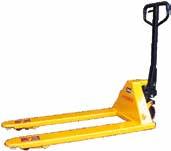


Varieties of Risk
Exposures and controls for inland marine property vary greatly by the type of risk. While most covered property is exposed to theft and vandalism, it is important to assess each risk individually and apply controls that are feasible and adequate to protect the assets.


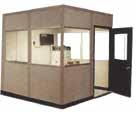


For builder’s risk insurance, the coverage limit is usually the forecasted amount of the completed project. This has become increasingly more difficult to predict with volatile commodity prices and dynamic labor costs. Factoring in the current challenges with supply chain management, costs can increase greatly over the course of construction. Therefore, protecting the build—from groundbreaking to ribbon-cutting—should include a good project management team and qualified contractors. Protections against loss should include secure fencing to enclose the entire project, good lighting, security patrols and signage, locked trailers and job boxes,

MATERIAL FLOW AND CONVEYOR SYSTEMS INC. Toll Free 877-868-3569 Phone 907-868-4725 Fax 907-868-4726 6112 Petersburg St. Anchorage, AK 99507 Visit Our Website: www.materialflow.com PALLET RACK Used and New Mezzanines - All Sizes and Types Two / Three Story Structures IN PLANT OFFICES Cheaper than stud wall construction. • Break Rooms • Admin. Offices • Drying & Curing Rooms • Equipment Enclosures • Growing Rooms • Guard Shacks • Cantilever Racks • Bulk Racks • Mezzanines • Lockers • Steel Shelving • Work Benches IN-STOCK IN-STOCK IN-STOCK IN-STOCK IN-STOCK IN-STOCK Manual Pallet Jacks • Gravity & Powered Conveyors • Bubble Wrap • Stretch Wrap Machines • Carousels • Turntables Hilman Rollers Plastic Bulk Boxes Plastic Bins Stretch Wrap - All Types Self Dumping Hoppers Steel Banding / Tools Packaging Supplies IN-STOCK Casters IN-STOCK Midwest Warehouse 100 Models in 39,000 Sizes Fast Shipment Sealing Tape MANY SIZES AVAILABLE Bulk Shelving & Racks • Carts • Hand Trucks • Platform Trucks www.akbizmag.com Alaska Business December 2022 | 79
Lloyd’s of London issued the first actual “all risk” ocean marine policies in 1688. The Marine Insurance Act of 1906 codified laws and regulations pertaining to ocean marine insurance, solidifying the coverages and laws that hold strong today.
and a formal process to ensure these protections occur. Video monitoring is a useful tool and can often be helpful for deterring theft, unwanted visitors, and monitoring the build over time.
Mitigating risk related to a build involves a few other considerations:

x Unwanted visitors attempting to camp or loiter anywhere near the build site should be addressed immediately.
x Natural events like wind, flooding, and earthquakes should be a priority consideration.
x Fire is always a big concern, so ensuring proper hot-work programs are in place, utilized, and enforced can help to mitigate associated risk.
x As winter arrives, inclement weather poses hazards to buildings that are not buttoned up. These exposures are normally addressed in the planning phase but should always be monitored as the build moves along.
Taking Control
For contractors' tools and equipment, loss prevention techniques include key control, company logos on mobile equipment, and enclosures. It is important to work with all the project’s contractors to have a complete security plan, including limiting the number of personnel with access to the site and equipment. Consider installing GPS systems to track job trailers and heavy equipment, in case of theft, as well as
installing secondary hidden electrical and fuel shut-off switches, especially since many pieces of equipment run off the same key. Keeping an inventory list of tools with photographs can be especially helpful should an insurance claim need to be filed.
Often this equipment must be transported to and from job sites. If a third party is hauling the equipment, ask if the carrier has motor truck cargo coverage. This inland marine insurance product can cover equipment being loaded and unloaded, as well as in transit, while under the care, custody,
and control of the trucking company. This is a free risk transfer to the equipment owner and ensures that any loss or damage to your equipment will be covered under the carrier’s insurance, not the equipment owners.
Fixed property covered under inland marine insurance, such as solar panels and wind turbines, should be secured against natural events such as wind, snow loads, and fire. Proper installation of the equipment is paramount and should be done by qualified contractors familiar with the product. Ensure the installers are properly insured for product completed operations prior to the start of any work. Snow and ice should be removed as needed, and frequent documented inspections are prudent.
Lastly, take time to look around your company’s assets. What needs to be protected? When considering a risk management program for inland marine insurance, turn to a commercial insurance agent for sage advice. Always select an insurance carrier that has free loss control services to reduce risks and increase your profitability. Step back, look around, and ask, “What could actually happen here?” Often that simple exercise of high-level risk assessment can reveal ground-level exposure. After all, it is a dynamic world out there and one never knows what might happen next. Always be prepared and informed.
It is important to work with all the project’s contractors to have a complete security plan, including limiting the number of personnel with access to the site and equipment.
The construction site at Bartlett Regional Hospital in Juneau controls for risk by the use of fencing, lighting, warning signs, and locked equipment.
80 | December 2022 Alaska Business www.akbizmag.com
Carter Damaska | Alaska Business

McKinley Management
Arctic Slope Regional Corporation is giving up its Alaska Growth Capital (AGC) subsidiary, which is becoming a fourth line of business for McKinley Management. Bristol Bay Native Corporation is partnering with McKinley as a shareholder of the renamed McKinley Alaska Growth Capital. Former AGC president Logan Birch, who switched to working for McKinley, is now in charge of AGC again. All AGC employees are being retained, and the company is colocating with McKinley's offices at the JL Tower in midtown Anchorage. mckinleycapital.com
Carrs-Safeway | Fred Meyer
The parent companies of Fred Meyer and Carrs-Safeway agreed to merge. Pending regulatory approval, Ohio-based Kroger would pay $24.6 billion for all outstanding shares of Idaho-based Albertsons, creating a combined company with 710,000 employees at 4,996 stores in fortyeight states. Fred Meyer stores employ more than 3,300 Alaskans; Carrs-Safeway, which combined in 1999, employs almost 3,000. Albertsons, which took over Safeway in 2014, would create a spinoff company named SpinCo to hold between 100 and 375 stores divested from the merged company, in hopes of maintaining competition. carrsqc.com | fredmeyer.com
Frontier Media
All six commercial radio stations in Juneau are being sold to an out-ofstate owner. Cliff Dumas, a morning
host in Bakersfield, California, is buying KINY, KJNO, KTKU, KSUP, KXXJ, and Hawk 107.9 from Frontier Media. The $1.3 million deal also includes two stations each in Sitka and Ketchikan, as well as Frontier Media’s six-station cluster in Texarkana, Texas. Dumas previously hosted a syndicated show with Frontier Media co-owner Sharon Burns. She and her husband Richard, both from Australia, became the first foreigners to own US broadcast licenses in 2017 when they acquired Juneau Alaska Communications. kinyradio.com
OfficeTECH | Kelley Connect
Office equipment supplier Kelley Connect is expanding its Alaska presence by acquiring Anchoragebased OfficeTECH. From its original founding in Spenard, OfficeTECH has established branches in Kodiak and western and eastern Washington. Seattle-based Kelley Connect already has sales offices in Anchorage, Soldotna, Fairbanks, Juneau, and Ketchikan, as well as Washington, Oregon, Idaho, and Montana. The addition of OfficeTECH means both Xerox and Quadient mail solutions are added to the Kelley Connect portfolio. kelleyconnect.com
ConocoPhillips
The Prudhoe Bay unit, still the largest oil field in North America, is getting larger with the addition of an adjacent area leased by ConocoPhillips. The ADL 47466 lease at Gwydyr Bay, northwest Prudhoe Bay, has been held by Conoco since 1969, with
only one well drilled and plugged in 1981. After years of dispute with state regulators, ConocoPhillips requested amending Prudhoe Bay to add Gwydyr Bay to the unit, splitting its shares with Prudhoe Bay’s other owners, ExxonMobil and Hilcorp. alaska.conocophillips.com
Alaska Plastics Recovery
A first-of-its-kind mobile plastics processor is being deployed in Alaska. The system fits in a 53-foot trailer and takes plastic collected from Alaska’s beaches and local communities, converting it into lumber-shaped products. American Cierra Plastics of Auburn, New York designed and built the processor for Alaska Plastics Recovery, a subsidiary of PKS Consulting. The first demonstrations were in Palmer and Seward. PKS Consulting’s president, Patrick Simpson, who is receiving funding from the US Environmental Protection Agency’s Small Business Innovation Research program, says he hopes “plastic can be viewed as a local resource and not as trash.” pksconsulting.biz
Tastee-Freez
The Tastee-Freez shop in West Anchorage is under new ownership for the first time in almost thirty years. Owner (and chief ice cream tester) Rich Owens retired September 1, passing the business at the corner of Raspberry Road and Jewel Lake Road to Linwood and Darlene Stowe, two former employees. Operating since 1958, the Tastee-Freez is the oldest location in the chain; Owens bought it in 1994. tfalaska.com
82 | December 2022 Alaska Business www.akbizmag.com
INDICATORS ANS Crude Oil Production 493,503 barrels 5.3% change from previous month 10/30/2022
Alaska Department of Natural Resources ANS West Coast Crude Oil Prices $92.99 per barrel 6.9% change from previous
of Natural Resources
Employment 360,700 labor force
unemployment
ECONOMIC
Source:
month 10/31/2022 Source: Alaska Department
Statewide
4.4%
9/1/2022. Adjusted seasonally.
INSIDE ALASKA BUSINESS
Source: US Bureau of Labor Statistics

Residential Mortgage

Residential Mortgage, the real estate subsidiary of Northrim Bank, named Chief Operating Officer Mike Baldwin to the role of President, as well. Baldwin has thirty-five years of experience in the mortgage industry. Before joining Residential Mortgage, he led four successful companies from startup. He holds a bachelor’s degree in business administration from University of the Pacific in Stockton, California.

Fairbanks Chamber of Commerce
The Greater Fairbanks Chamber of Commerce board hired Jeremy Johnson as its new President and CEO, ending a five-month search. Johnson was born and raised in Fairbanks and has spent the last sixteen years in public service in various positions, from advising and assisting local governments to conducting elections. He holds a degree in political science from UAF and has received several Governor’s Denali Peak Performance Awards for his service from 2009 to 2015.
Chugach Alaska Corporation

An executive at Chugach Alaska Corporation is promoted to President. In her new role, Josie Hickel is responsible for leading land management and resource development strategy for the Alaska Native corporation that spans the coastal region



from the Kenai Peninsula to Cordova. Hickel previously served as executive vice president of ANCSA and community affairs. Hickel is of Aleut descent and a Chugach Alaska shareholder from Seward; the late former governor Wally Hickel was her father-in-law. Prior to joining Chugach, she served as chief administrative officer for Petro 49, a fuel distributor throughout Alaska and the Yukon Territory.
Koniag Government Services
A subsidiary of the Alaska Native corporation for the Kodiak Island region has a new Chief Information Officer (CIO). Ray Coleman brings Koniag Government Services (KGS) more than twenty-five years of experience in IT and cybersecurity as a US Army veteran. As CIO, Coleman is responsible for overseeing IT systems and cybersecurity for KGS’ professional services to federal government agencies. He provides technical leadership and maintains an up-to-date vision for future technology needs.
dual bachelor’s degrees in the French language and journalism and public communication from UAA. Bryan has fifteen years of director-level marketing and communication experience in a variety of sectors, spanning economic development, state/local/federal contracting, construction, and healthcare. Her most recent position was as communications director for a public corporation within the Alaska Department of Commerce, Community, and Economic Development.
Doyon Foundation
Shee Atiká
Shee Atiká, the Alaska Native corporation for Sitka, named Colleen Bryan as its new Marketing and Communications Director. In that position, Bryan is responsible for all internal and external communications. Bryan holds a master’s degree in technical communication from Minnesota State University, Mankato and
Doyon Foundation, the charitable arm of the Alaska Native corporation for the Interior region, selected Mariah Pitka-Jenkins as its new Executive Director. PitkaJenkins, originally from Galena, has served on the foundation’s board of directors since 2019. Pitka-Jenkins received a scholarship from Doyon Foundation as a graduate of Bristol Bay Borough High School. She earned an associate certificate in project management from George Washington University and obtained her executive leadership certificate from the University of California Berkeley in 2013. She joined Doyon, Limited in 2002, starting in accounting and working her way up to senior vice president and general manager for Doyon Remote Facilities & Services.
The Nature Conservancy
The Nature Conservancy, a national environmental nonprofit, named Ivy Spohnholz as its next Alaska State

Keeping Alaska Open for Business
Johnson
Bryan
Hickel
Coleman
Pitka-Jenkins
84 | December 2022 Alaska Business www.akbizmag.com
RIGHT MOVES
RIGHT MOVES IS BROUGHT TO YOU BY NORTHERN AIR CARGO
Director. Spohnholz has served six years in the Alaska House of Representatives and did not seek a fourth term in her Northeast Anchorage district.
Spohnholz’s career spans twenty years in roles with organizations ranging from The Salvation Army, Abused Women’s Aid in Crisis, and the Alaska Conservation Foundation, chiefly focusing on developing partnerships and attracting private investment. She is also a past board chair of the Alaska Children’s Trust. Spohnholz holds a bachelor’s degree in political science and a master’s degree in public administration, both from the University of Washington.

RurAL CAP
Rural Alaska Community Action Program (RurAL CAP) hired John Stackhouse to be the nonprofit’s Chief Financial Officer. Stackhouse was previously the director of finance at Covenant House Alaska. He also worked as the business manager for the Yupiit School District in Akiachak for four years before relocating to Anchorage in 2021. Stackhouse served in the US Navy for twenty-four years and retired as a chief petty officer. He earned master’s degrees in business administration and management from the University of Maryland.
Carlile Transportation
Carlile Transportation promoted Christen Van Treeck to the position of Vice President of Carlile Logistics. In her new role, Van Treeck leads key projects throughout Alaska and North America. Van Treeck

previously served as Director of Logistics and Customer Service. She started her thirty-year career in transportation with Carlile while she was in high school, working as a file clerk. Van Treeck continued with Carlile full time as a billing supervisor while putting herself through college, graduating from UAA in 2003 with a bachelor’s degree in global logistics.
MBA Consulting Engineers


A senior employee at MBA Consulting Engineers is rising to the role of Principal. The Anchorage-based company is promoting Scott C. Hala, a senior mechanical engineer, to succeed Chief Mechanical Engineer Bradley S. Sordahl upon Sordahl’s retirement in the spring. Hala joined MBA after receiving his bachelor’s degree in mechanical engineering from Rensselaer Polytechnic Institute in 2000. He enjoys fishing on the Kenai River and spending time with his family.


Coffman Engineers
Spencer Osgood, an engineer at the Anchorage office of Coffman Engineers, earned his Alaska Professional Engineering license in civil engineering. Osgood graduated from Colorado State University in Fort Collins with a bachelor’s degree in civil engineering. He joined Coffman in 2016 as an intern performing cathodic protection surveys with the corrosion control department. After graduating, he transitioned to a full-time position in the civil engineering department. Osgood’s experience includes commercial, industrial, and military projects throughout Alaska and Pacific islands. He has knowledge of hydrological
engineering as well as site design, project coordination and design, permitting, trenchless utility design, and fuel storage containment. He is also a certified cathodic protection technician.

Koahnic Broadcast Corporation
Anchorage-based media nonprofit Koahnic Broadcast Corporation added some new hires to its news, production, and administrative teams.

Award-winning presenter Shawn Spruce is now the permanent Host of Native America Calling, a nationally syndicated radio program. Spruce, of the Laguna Pueblo, was a frequent guest on the show and made an impression as someone who could connect with audiences. Spruce was awarded the 2021 Ketchum Prize for outstanding contributions to financial education.
Sol Traverso joins Native America Calling as Associate Producer. Originally from Alaska, Traverso is a University of New Mexico journalism graduate with three years of experience that includes reporting for the university’s Daily Lobo and New Mexico News Port and the weekly Taos News.
Andi Murphy is promoted to Senior Producer on Native America Calling after working on the show for eight years. The frequent fill-in host specializes in Indigenous multimedia storytelling, production, and research. Murphy is a twotime winner of the National Native Media Award for general excellence in podcasting and radio.
Koahnic’s Anchorage-based radio station KNBA also welcomed two new junior-level positions: Hanna Bissett as News Intern and Kayla Rearden as Administrative Assistant.
Spohnholz
Van Treeck
Hala
Stackhouse
For more information, please visit us at www.nac .aero. Northern Air Cargo is committed to getting your cargo where it needs to be, on time, so you can worry about what really matters. www.akbizmag.com Alaska Business December 2022 | 85
Osgood
The Alaska State Hospital and Nursing Home Association, or ASHNHA, shortened its name in June, becoming the Alaska Hospital and Healthcare Association, or AHHA.
Despite losing the “S,” the association still advocates for the healthcare industry statewide, and despite losing the “N,” nursing homes are still under its umbrella. Established in 1953, AHHA represents more than sixty-five hospitals in Alaska, as well as nursing facilities, home health agencies, and other healthcare partners. It also represents Alaska in national healthcare networks: the American Hospital Association, the American Health Care Association, and the National Center for Assisted Living.
The organization publishes an annual analysis of the Alaska healthcare workforce. The most recent edition (as of this writing), prepared by Rain Coast Data with figures from 2020, reports strong growth in healthcare wages and employment. Indeed, the healthcare sector is one of the few to employ more people now than before the economic disruption wrought by COVID-19, according to monthly figures from the Alaska Department of Labor and Workforce Development.
Even before the pandemic, AHHA found that Alaska has a greater prevalence of frontline family medicine physicians than the national average, which is handy for anyone scheduling a doctor’s appointment. Alaska is lower than average in the prevalence of nursing assistants and licensed practical nurses, so there is room for improvement.
For this month’s Alaska Trends, we give the healthcare workforce a thorough examination to diagnose its areas of strength. Open wide and say AHHA!
Economic Impact
The healthcare sector pays more combined wages than any other industry.
Workforce Earnings by Industry
21% Increase
Healthcare wages have increased by $491M (21%) from 2016 to 2020.
11%
of Alaska's workforce is in healthcare.
Healthcare 11% Professional 9% Trade 7% Oil & Mining 8% Military 9% Construction 7% Transportation 6% Financial 6% Local Gov't 8% State Gov't 6% Federal Gov't 5% Tourism 5% Other 9% Fishing & Timber 4%
$3B in Wages paid by the healthcare industry in 2020.
Northern
Southwest 14% Southeast 14% Gulf Coast 12% Anchorage 9% Fairbanks 8% Mat-Su 8% Rural/Interior 7%
4,981 Nonresident healthcare workers employed throughout the state.
20%
86 | December 2022 Alaska Business www.akbizmag.com
SOURCE: Alaska State Hospital & Nursing Home Association, Alaska Health Care Workforce Analysis, November 2021
ALASKA TRENDS
OCCUPATION
Medical and Health Services Managers
Healthcare Practitioners/Technical Occupations
NUMBER
OF JOBS HOURLY WAGE ANNUAL INCOME PROJECTED GROWTH
1,070 $59 $122,430 8%
17,730 $50 $104,000 8%
Chiropractors 130 $43 $90,320 9% Dentists 220 $117 $242,850 10% Dietians/Nutritonists 130 $38 $78,350 5%
Optometrists 120 $71 $146,680 8% Pharmacists 470 $71 $147,040 4%
Physician Assistants 430 $72 $150,430 8% Occupational Therapists 270 $45 $93,980 7%
Physical Therapists 610 $49 $101,190 8% Respiratory Therapists 190 $36 $74,390 6%
Speech-Language Pathologists 260 $42 $87,250 6% Therapists, All Other ** $26 $53,210 8%
Veterinarians 240 $48 $100,000 24%
Registered Nurses 6,240 $46 $95,270 7%
Nurse Midwives 50 $45 $93,080 10%
Nurse Practitioners 770 $53 $110,270 9% Audiologists 40 $41 $84,410 7%
Dental Hygienists 610 $55 $115,050 9%
Clinical Laboratory Technologists/ Technicians 680 $33 $69,390 8%
Cardiovascular Technologists/Technicians ** $30 $63,240 8%
Diagnostic Medical Sonographers 160 $46 $95,990 8%
Radiologic Technologists/Technicians 370 $38 $79,330 8%
Magnetic Resonance Imaging Technologists 70 $44 $91,360 8%
Emergency Medical Technicians/Paramedics 600 $24 $50,030 7%
Dietetic Technicians 40 $20 $41,860 9%
Pharmacy Technicians 610 $22 $46,430 2%
Psychiatric Technicians 310 $20 $42,320 9%
Surgical Technologists 230 $32 $67,120 7%
Veterinary Technologists/Technicians 220 $20 $42,330 27%
Ophthalmic Medical Technicians ** $24 $50,880 8%
Licensed Practical/Vocational Nurses 330 $33 $67,620 10%
Opticians, Dispensing 90 $28 $57,480 5%
Healthcare Support Occupations 13,490 $20 $42,080 11%
Home Health/Personal Care Aides 6,480 $17 $35,360 23%
Nursing Assistants 1,800 $20 $42,500 8%
Orderlies 70 $19 $38,480 7%
Psychiatric Aides 150 $20 $41,880 1%
Physical Therapist Assistants 120 $28 $59,230 8%
Physical Therapist Aides 30 $18 $37,260 9%
Massage Therapists 510 $38 $78,790 8%
Dental Assistants 920 $25 $51,230 9%
Medical Assistants 2,500 $22 $46,610 9%
Medical Equipment Preparers 220 $24 $50,350 5%
Medical Transcriptionists 110 $18 $36,520 9%
Veterinary Assistants/Laboratory Animal Caretakers 140 $16 $33,720 26%
Phlebotomists 240 $21 $43,270 8%
Nursing & Residential Care
Hospitals are the largest healthcare employer in the state followed by outpatient care. Nursing and residential care facilities account for 11% of all workers.
Outpatient Healthcare 23,199 Hospitals 15,170 Nursing Care/Residential Care Facilities 1,720 Mental Health/Substance Abuse Facilities 1,432 Elderly Community Care 1,469
Personal Care
Home Health and Personal Care Aides have one of the lowest average wages but expect twice the projected growth of Healthcare Support Occupations.
Animal Health
Veterinary Technologists/ Technicians, Veterinary Assistants/ Laboratory Animal Caretakers, and Veterinarians expected to grow by more than 20% in the next 10 years.
Jobs, Wages &
Projected Growth
www.akbizmag.com Alaska Business December 2022 | 87
What book is currently on your nightstand?
Dare to Lead: Brave Work. Tough Conversations. Whole Hearts. by Brené Brown.
What charity or cause are you passionate about?
Life Alaska Donor Services. I’m a board member.
What’s the first thing you do when you get home after a long day at work?
Take off my shoes [she laughs].

What vacation spot is on your bucket list?
Australia and New Zealand.
If you could domesticate a wild animal, what animal would it be?
The summer we’ve had has been very active with bears where I live in Eagle River, so if we could make them cute, cuddly, little friends, that would put my mind at ease.
88 | December 2022 Alaska Business www.akbizmag.com
Photo Arts by Janna
Codie Costello
Arts keep Codie Costello on her toes. For example, earlier this year she directed the one-woman play No More Harveys for Cyrano’s Theatre Company. That stage is much smaller than the four inside the building she manages as president and COO of the Alaska Center for the Performing Arts (PAC), the nonprofit that operates the city-owned facility.

The PAC first caught her eye when she visited Alaska for her honeymoon. “I couldn’t believe that a community of this size had a building like this,” she recalls. “It was shocking.” When the time came to leave New York City, Costello applied for a job at the PAC and moved to Anchorage, and now she can’t imagine anywhere else being home.
What’s left for an artist, after being a performer, director, producer, and president? “I’m gonna be a volunteer usher someday,” she says. “That group of people are amazing, and I should only be so lucky to be welcomed into those ranks at some time in the future.”
Alaska Business: What do you do in your free time?
Codie Costello: Right now, we’re building a house, so just being on our property and exploring with the kids and my husband. Making our dream come to life is pretty amazing.
AB: Is there a skill you’re currently developing or have always wanted to learn?
Costello: If I could, like, belt out a tune like the most amazing singers on the planet do, I’ve always wondered, what would that feel like? [she laughs] Because it’s certainly not happening for me when I’m driving my car.
AB: What’s the most daring thing you’ve ever done?
Costello: Moving to New York City, sight unseen, when I moved there to go to grad school… when I was 26.
AB: What’s your favorite local restaurant?
Costello: A recent find that I hadn’t tried before that I was just like, ‘Oh my gosh! This is amazing!’ is Tent City [Taphouse, two blocks from the PAC].
AB: Other than your current career, if you were a kid today, what would your dream job be?
Costello: As a kid, I was a pretty avid ballet dancer. That was a short-lived career. If I could’ve really taken off with a long and successful professional career as a ballet dancer, that was my dream.
AB: What is your favorite way to exercise? Costello: I do love yoga, but I also love being outside, walking.
AB: Dead or alive, who would you like to see perform live in concert? Costello: I would’ve loved to have the chance to see Baryshnikov when he was at his height. Or Margot Fonteyn.
AB: What’s your greatest extravagance?
Costello: Shoes… I have a lot of them.
AB: What are you superstitious about?
Costello: The idea of karma. Yeah.
AB: Have you had a supernatural experience?
Costello: I lost a dear friend when I was 19. She drowned; it was a significant tragedy in my life. For years afterward, there would be these moments where I would think that I saw her—when I was awake… That always was, like, ‘Huh. Maybe? What if?’… Not lately. At first it was upsetting, but then it became kind of comforting.
AB: What’s your best attribute and worst attribute?
Costello: I think my best attribute is inspiring others with big ideas, but I also think sometimes too many can come at once, so maybe that’s my worst as well.
www.akbizmag.com Alaska Business December 2022 | 89 OFF THE CUFF
3-Tier Alaska ...................................................... 23 3tieralaska.com
Airport Equipment Rentals ................................ 91 airportequipmentrentals.com
Alaska Communications Systems 3 acsalaska.com
Alaska Hospital & Healthcare Association .........51 www.ashnha.com
Alaska Humanities Forum 43 akhf.org
Alaska Mergers & Acquisitions, LLC ............................................... 41
Alaska Pacific University 43 alaskapacific.edu
Alaska School Activities Association 63 asaa.org
Altman, Rogers & Co. ........................................ 41 altrogco.com
American Heart Association 61 heart.org
Anchorage Convention Centers ........................ 17 anchorageconventioncenters.com
AT&T 25 att.com

Avis Rent-A-Car 73 avisalaska.com
Bettisworth North ............................................. 59 bettisworthnorth.com
Business Insurance Associates Inc 49 businessinsuranceassociates.com


Central Environmental Inc .................................21 cei-alaska.com
Chugach Alaska Corporation............................ 19 chugach.com
ConocoPhillips 77 alaska.conocophillips.com
Conrad-Houston Insurance Agency .................75 chialaska.com
Construction Machinery Industrial 2 cmiak.com
Cook Inlet Tug & Barge Inc ............................... 49 cookinlettug.com
Credit Union 1 .....................................................71 cu1.org
First National Bank Alaska 5 fnbalaska.com
Great Originals Inc ............................................ 29 greatoriginals.com
Lifemed Alaska 47 lifemedalaska.com
Lynden ............................................................... 92 lynden.com
Material Flow & Conveyor Systems, Inc. .......... 79 materialflow.com
Medical Park Family Care, Inc 57 mpfcak.com
NCB .................................................................... 69 ncb.coop
Nenana Heating Services, Inc 69 nenanaheatingservicesinc.com
New Horizons Telecom, Inc. ............................ 13 nhtiusa.com
Northern Air Cargo...................................... 84, 85 nac.aero
Oxford Assaying & Refining Inc 67 oxfordmetals.com
Pacific Pile & Marine .......................................... 83 pacificpile.com
Parker, Smith & Feek 9 psfinc.com
Providence Health & Services Alaska ............... 53 providence.org
Schwabe, Williamson & Wyatt ...........................37 schwabe.com/locations-anchorage-alaska
Southcentral Foundation 35 southcentralfoundation.com
Span Alaska Transportation ...............................15 spanalaska.com
T. Rowe Price 7 alaska529plan.com



Think Office ....................................................... 81 thinkofficellc.com
UAF eCampus .....................................................31 ecampus.uaf.edu
United Way of Anchorage 33 liveunitedanc.org
USI Insurance Services ...................................... 39 usi.com
Westmark Hotels - HAP Alaska 75 westmarkhotels.com

'Follow' us on social media Use Promo Code: XMAS22 A 1-year PRINT & DIGITAL subscription to Alaska Business and the Annual Power List. GET YOUR SUBSCRIPTION TO AWARD-WINNING BUSINESS NEWS Regular price $39.95 Sales Price: $20 The Perfect Gift! 90 | December 2022 Alaska Business www.akbizmag.com ADVERTISERS INDEX
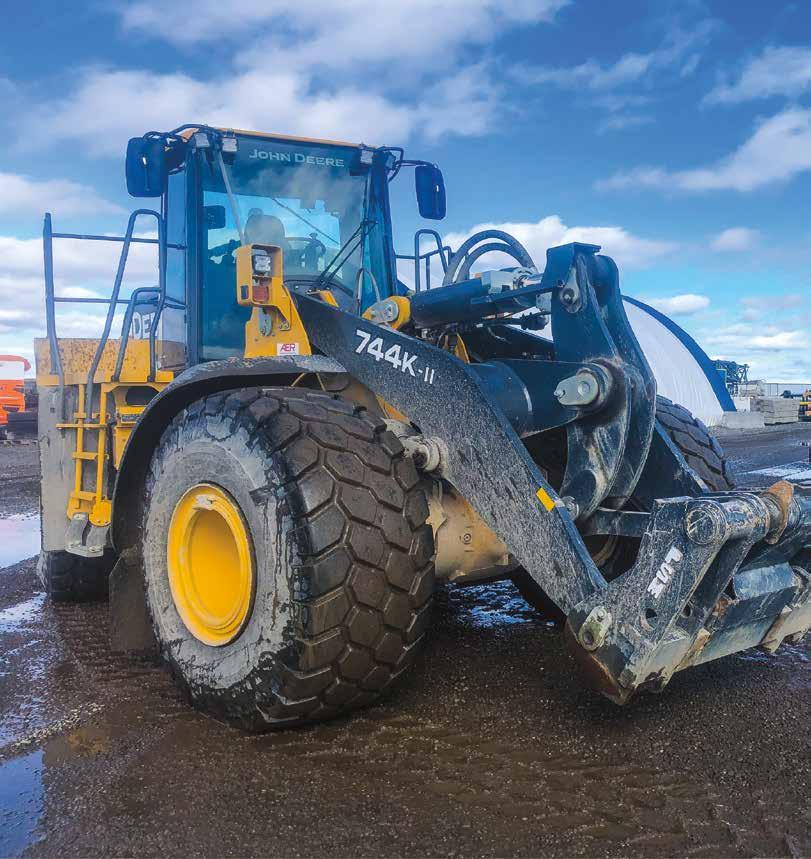

























JOHN DEERE 744K-II Built North Slope Tough - 4WD with Locking Diffs - 40,000 LB Lifting Force - Standard - Bucket, Forks, Stinger - Scrapers Available Delta Junction 907.895.9898 Anchorage 907.522.6466 Kenai 907.335.5466 Prudhoe Bay 907.659.2000 Fairbanks 907.456.2000 The Rental Zone 907.474.2000 www.airportequipmentrentals.com
Thank You Alaska!


Thank you to our friends, neighbors, and valued customers for your ongoing support and partnership, and special thanks to each of our dedicated employees for their continued care, expertise, and ingenuity as we all work together to keep Alaska moving. We look forward to continuing to serve our communities by providing multi-modal transportation and logistics solutions across the entire state!












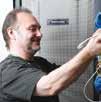






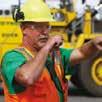

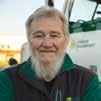



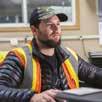


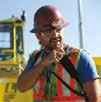
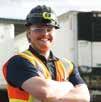








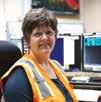










 Christy Constantini Executive Director
Christy Constantini Executive Director



























 By Tracy Barbour
By Tara O’Hanley
By Rindi White
By Richard Perry
By Tracy Barbour
By Tara O’Hanley
By Rindi White
By Richard Perry




 By Vanessa Orr
By Vanessa Orr













 The stability and reliability of 5G phone and internet erase much of the inconvenience of working remotely.
The stability and reliability of 5G phone and internet erase much of the inconvenience of working remotely.
 Downtown Fairbanks is next in line for 5G service, after GCI furnishes the North Slope so that industrial users have access to the technology now in place in Anchorage and the Mat-Su Borough.
Downtown Fairbanks is next in line for 5G service, after GCI furnishes the North Slope so that industrial users have access to the technology now in place in Anchorage and the Mat-Su Borough.






 By Vanessa Orr
By Vanessa Orr












































 By Tara O’Hanley
By Tara O’Hanley


 Matson's Caring for Alaska program supports creek cleanups in Anchorage (above), and the company donates its shipping services to haul out recyclable materials (below).
Matson's Caring for Alaska program supports creek cleanups in Anchorage (above), and the company donates its shipping services to haul out recyclable materials (below).








 Participating in the Anchorage Chamber of Commerce citywide cleanup puts Matson’s logo in a positive light, in addition to tidying up the community where the company’s employees live.
Participating in the Anchorage Chamber of Commerce citywide cleanup puts Matson’s logo in a positive light, in addition to tidying up the community where the company’s employees live.






































 Providing for volunteer time off is not just a perk for employees but a benefit for nonprofit partners, like the Anchorage Chamber of Commerce and its citywide cleanup.
Providing for volunteer time off is not just a perk for employees but a benefit for nonprofit partners, like the Anchorage Chamber of Commerce and its citywide cleanup.




 Erec S. Isaacson, President ConocoPhillips Alaska
Erec S. Isaacson, President ConocoPhillips Alaska


















 Midas later in training to become a service dog.
Dog Works Training Co.
Cassmus completed the Canine Good Citizenship test, part of foundational obedience training for any therapy or service dog.
Dog Works Training Co.
Visiting the dentist doesn’t have to be stressful when Lucy is around.
Midas later in training to become a service dog.
Dog Works Training Co.
Cassmus completed the Canine Good Citizenship test, part of foundational obedience training for any therapy or service dog.
Dog Works Training Co.
Visiting the dentist doesn’t have to be stressful when Lucy is around.
















 The Great Room at Maple Springs in Anchorage echoes the grand lodges of Alaska.
Maple Springs’ outdoor courtyard is an ideal space for residents to enjoy nature and engage in activities and conversation.
The Great Room at Maple Springs in Anchorage echoes the grand lodges of Alaska.
Maple Springs’ outdoor courtyard is an ideal space for residents to enjoy nature and engage in activities and conversation.

























 Renderings show the new lobby (above) and wheelchair lift in the stairwell (below) at Identity Health Clinic in Midtown Anchorage, part of an ongoing expansion project.
Renderings show the new lobby (above) and wheelchair lift in the stairwell (below) at Identity Health Clinic in Midtown Anchorage, part of an ongoing expansion project.










 Innovations in pain management over the last two decades mean that opioid medication is no longer the first-line choice.
Innovations in pain management over the last two decades mean that opioid medication is no longer the first-line choice.












 Vaccinations and testing for COVID-19 kept waste disposal companies busy during the pandemic, even while routine medical procedures were postponed.
Vaccinations and testing for COVID-19 kept waste disposal companies busy during the pandemic, even while routine medical procedures were postponed.





























 By Amy Newman
By Amy Newman


 There are no hot springs in Girdwood, so Alyeska Nordic Spa provides its own hot and cold pools for the complete hydrotherapy cycle.
Kristian Irey Alyeska Resort
A Forest Walk connects spa facilities to the spruce and hemlock trees surrounding Alyeska Resort.
There are no hot springs in Girdwood, so Alyeska Nordic Spa provides its own hot and cold pools for the complete hydrotherapy cycle.
Kristian Irey Alyeska Resort
A Forest Walk connects spa facilities to the spruce and hemlock trees surrounding Alyeska Resort.







 Two Trees Bistro is open to spa visitors, with dining focused on local ingredients and a menu curated by Chef Wes Choy.
Two Trees Bistro is open to spa visitors, with dining focused on local ingredients and a menu curated by Chef Wes Choy.





































































































